




By Amber Ogden STAFF WRITER
By Ebony JJ Curry SENIOR REPORTER
During Black Maternal Health Week 2025, Detroit-based non-profit Mothering Justice is making national waves with its powerful advocacy work to dismantle the systemic inequalities that put Black mothers at risk. With Michigan’s Black maternal mortality rate more than twice that of white mothers, this week serves as both a moment of reflection and a rallying cry for change.
By Ebony JJ Curry SENIOR REPORTER
Late Thursday night, Sept. 14, a historic moment unfolded in American labor relations as the United Auto Workers (UAW) union initiated a strike against Ford, General Motors (GM), and Stellantis. For the first time, the union took simultaneous action against all three major Detroit-based automakers. The action involves approximately 13,000 UAW members in assembly plants across Michigan, Ohio, and Missouri, who walked off their jobs after existing labor contracts expired at 11:59 p.m.
Founded in 2012, Mothering Justice has been a driving force in elevating the voices of mothers of color and pushing for family-supportive policies across Michigan and beyond. As part of Black Maternal Health Week, the organization hosted community-centered events, policy forums, and storytelling campaigns designed to educate, empower, and spark systemic reform.

their city is a powerful testament to the resilience and ingenuity of our community.
In a breathtaking celebration of talent, determination, and the unyielding spirit of Black excellence, the Michigan Chronicle marked its 10th Annual 40 Under 40 event Thursday evening. This year’s soirée, drenched in the theme “All Black Everything with Gold Accents,” transcended expectations and essentially illuminated the golden gems within the true essence of Black excellence. Hosted by the charismatic duo of Andre Ash and Lynzee Mychael from Michigan Chronicle’s Finally Friday, the night was a triumph for the city of Detroit and its vibrant community of young Black pro-

According to the Michigan Department of Health and Human Services, Black women in the state are two to three times more likely to die from pregnancy-related complications than white women. This disparity isn’t just a statistic; it’s a public health crisis rooted in racism, bias in medical care, and lack of access to quality resources.
President of Mothering Justice Danielle Atkinson says the statistics paint a picture of what Black mothers feel every day.
Shortly before midnight on Sept. 14, GM released a statement expressing disappointment with the strike action, despite offering what it termed an “unprecedented economic package” that included historic wage increases. Stellantis also expressed disappointment in a statement, saying the company immediately went into contingency mode to protect its operations.
As the night unfolded, we had the privilege of honoring other outstanding individuals, each carving their own path to success. Clement “Fame” Brown, the creative mind behind Three Thirteen Detroit’s Brand Name, received the prestigious Entrepreneur of the Year Award. Brown’s commitment to empowering the city through fashion and entrepreneurship has left an indelible mark.
By Ebony JJ Curry SENIOR REPORTER
The evening sparkled with a golden promise as we celebrated remarkable individuals from various walks of life. Among the honorees were the brilliant and visionary co-founders of Detroit Hives, Nicole Lindsey and Timothy Paul Jackson. Their work has not only changed the landscape of beekeeping and urban farming in Detroit but also exemplified the transformative impact Black professionals can have on their communities.
“Entrepreneur of the year – that’s a big deal,” said Brown. “It’s always an honor to be honored and it’s always a blessing to be in a room full of so many talented, accomplished, and popular people that look like me. I’m geeked. I started making and selling clothes as a kid and I always knew that I would have a business, but I never knew it would be Detroit’s brand name business, so I take a lot of pride in the fact that our business represents our city’s pride.”
Greektown Had 1.4 Million Visits This Summer and No Shootings
By Ebony JJ Curry SENIOR REPORTER
“Together we have created a social, environmental, and financial impact through bees,” said Jackson. Lindsey followed that sentiment with, “It is through our local partnerships and collaborative efforts that we exist in over 28 plus locations managing the health of 4.5 million honeybees – humbly speaking our movement has inspired others locally, nationally, and even internationally to take on similar missions.”
“The United States has one of the highest maternal mortality rates of developing countries, with black mothers three to four times more likely to die of pregnancy-related complications than white mothers; despite the decline in the overall death numbers, black mothers remain unchanged,” Atkinson said.
The view from the 16th floor of One Campus Martius says a lot about Detroit— its grit, its progress, and its unfinished business. But on this morning, the skyline was met with something even more powerful: an unfiltered conversation that stretched far beyond Michigan. The Michigan Chronicle’s Pancakes & Politics Forum 2 wasn’t business as usual. It was national in scale, local in impact, and deeply personal for the communities caught in the crossfire of political chaos and federal disinvestment.
Taking home the Corporate Excellence Award was Dannis Mitchell, Director of Community Engagement at Barton Malow.
For many Detroiters, Interstate 375, or I-375, has long been just another stretch of urban highway, a concrete artery connecting different parts of the city. To some, it’s a mere convenience; to others, it’s an unremarkable part of their daily commute. However, there’s a deeper, far more troubling story beneath the surface of this seemingly ordinary freeway—a story of pain, displacement, and the lasting impact on Black Detroiters.
Detroit Hives, a pioneering organization founded by Lindsey and Jackson, harnesses the power of urban beekeeping to revitalize neighborhoods in the Motor City. Their initiative not only addresses critical issues like environmental conservation but also provides valuable education and employment opportunities to Black De-
The UAW has branded the industrial action as the “Stand-Up Strike,” focusing on specific plants within each automaker. UAW President Shawn Fain stated, “This strategy will keep the companies guessing. It will give our national negotiators maximum leverage and flexibility in bargaining. And if we need to go all out, we will. Everything is on the table.” Union leaders have also indicated that additional plants could be targeted in future waves if negotiations remain stalled.
During Black Maternal Health Week, Mothering Justice focused on reproductive justice. This framework addressed access to maternal care and considered the social, political, and economic conditions that impact a person’s ability to parent with dignity.
“It is so important to recognize that there are young leaders across the country, many that are born here in Detroit. I represent our city nationally and I tell people, ‘Yea I’m a D-girl I’m from the west-side of Detroit,’” Mitchell expressed. “But more importantly, I’ve been able to have experiences within an industry that not many of us, specifically women of color, have the opportunity to engage in and I’ve been the youngest person in the room, the only Black person in the room, and the only Sistah in the room, and I really had to articulate the importance of showing up, giving chances when others won’t, and being persistent.” As a trailblazing Black woman thriving in a predominantly male-dominated industry, her unwavering commitment to fortifying the connections between businesses and Detroit’s communities is unde-
that’s marked his role from the very beginning. His tone challenged panelists to speak plainly, think boldly, and ground their insights in reality. Archer quickly raised a cultural and economic question rooted in the Black experience—referencing The Banker, an Apple TV film based on the true story of two Black brothers in the 1960s who built a bank to counteract racist lending systems. Turning to David Egner, he asked plainly: “If you and I walk into a bank wearing the same suit, do you believe a white man would walk out with a higher loan than I would because I’m Black? Fast forward to today and our future, is there a real threat to the banking industry and Fair Lending Act?”
DPD Chief James White Says Increased Police Presence Culled Violence
By Andre Ash
ness district that had been the lifeblood of the community.
DIGITAL ANCHOR
towards mending the wounds inflicted on Black Detroiters and restoring a sense of belonging that was so callously torn away in the past.
to strip the university’s funding, labeling it “a joke” that teaches “hate and stupidity.” Archer’s question to Don Graves landed hard: “What the hell is happening in D.C.?” Graves didn’t hold back. “This is not a blip. This is the new reality. We are entering a fundamental revolution in how we operate,” he said. “The U.S. was once the global economic leader because of a rules-based international order. It protected human rights, worker rights, and used the best capital system in the world. We operated on predictability, transparency, and clarity. Now that’s being swept away.”
It’s a history marred by pain, injustice, and economic devastation. More than 130,000 residents, primarily Black, were forcibly displaced. Families were uprooted, generational wealth was obliterated, and a thriving community was torn asunder. The wounds inflicted by I-375 run deep, transcending the physical barrier of a freeway to penetrate the very soul of Black Detroiters.
That question, deeply personal yet policy-relevant, anchored the morning.
The I-375 Boulevard Project is about more than just correcting historical injustices; it’s about redefining the future. It will connect downtown Detroit to surrounding neighborhoods, bridging the gap that was placed upon the city decades ago.
“Mothering Justice’s theme for 2025 is rooted in resistance,” Atkinson said.
By Andre Ash DIGITAL ANCHOR
“Throughout history, mothers have led marginalized communities in resisting oppression and fighting for their rights and demanding justice to be rooted in the resistance.”
The tale begins in what is now Lafayette Park, once known as Black Bottom—a neighborhood rooted in African-American culture and history. Named after its dark, fertile soil, Black Bottom flourished during the mid1900s, nurturing the dreams and aspirations of prominent Detroiters like Coleman Young, Joe Louis, and numerous other Detroit legends. But in the name of urban renewal in the 1950s, this vibrant neighborhood was systematically dismantled, erased from the map, and replaced by a lifeless stretch of asphalt.
A string of shootings in Greektown in mid-April left both visitors and residents of this bustling downtown destination in awe. One of these shootings tragically claimed the life of a popular and beloved security guard following a dispute with a patron. The male suspect allegedly shot the guard before fleeing the scene, while his female companion is accused of concealing the weapon in her bra.
This painful legacy can be traced back to the nation’s interstate highway program of 1956—a program that aimed to connect the country but often did so at the expense of marginalized communities. In the case of I-375, it meant carving a path through the heart of Black Detroit, reinforcing segregation, and perpetuating inequality.
A Holistic Approach to Providing Shelter and Support for Detroit’s Unhoused People
Fain clarified the union’s strategy: “I want to give a major shoutout to the thousands of members who are on the picket lines right now fighting for all of us. The Stand-Up Strike is a new approach to striking. Instead of striking all plants at once, select locals will be called on to stand up and walk out on strike. This is our generation’s answer to the movement that built our union – the sit-down strikes of 1937. We told the Big 3 that Sept. 14 was the deadline and we meant it. We gave the companies our economic demands eight weeks ago and it took more than a month to get to the table.”
For the first time in the forum’s 20year history, national voices were flown in to sit beside Michigan’s most respected local leaders. The panel consisted of Nicole Sherard-Freeman, President of Community Foundation for Southeast Michigan; Don Graves, former U.S. Deputy Secretary of Commerce; David Egner, President and CEO of Ralph C. Wilson Jr. Foundation; Kelly Kuhn, President and CEO of Michigan Nonprofit Association and Michael T. Pugh, national CEO Local Initiatives Support Corporation. Their charge: confront the consequences of vanishing federal support, dissect the urgency of the current political climate, and offer a strategy that bridges national discourse with community needs.
Mothering Justice kicked off Black Maternal Health Week with a powerful series of community-centered events that brought together Black mothers, advocates, birth workers, and allies from across Michigan. From a soulful liberation ceremony at Artist Village
While the residential areas bore the brunt of this demolition, the heart of Black Bottom, its thriving business center, remained largely untouched. Restaurants, theaters, clubs, and bars—the very places that brought Detroit’s Black community together—were concentrated around Hastings Street, the epicenter of African-American culture in the city.
Housing Resource Helpline in response to the challenges that residents face in navigating the complex system of housing services. The helpline provides a single point of contact for people seeking housing assistance and connects them with the resources they need.
Pugh, a national leader in finance, brought the conversation back to infrastructure and investment. His remarks highlighted the urgency of building systems that go beyond housing. “If you support and provide housing, you have to provide the wraparound services of a healthy ecosystem,” Pugh said. “We must focus on strategic investments. Local leadership is vital because they know what’s happening in the community. And when it comes to affordable housing, everyone in the room must advocate for the Community Reinvestment Act. We need CDFIs to have a strong presence. We have to continue talking about investment impact when we talk about CRA.”
These incidents unfolded during an unseasonably warm spring, leading to increased pedestrian traffic and heightened tensions in the densely populated downtown area.
His response peeled back the layers of political dysfunction. “There is an attack on every institution—governance, higher education, the legal system. The governing principle is chaos. For nonprofits and businesses, the ability to conduct work with certainty is gone,” Graves said. “We must now get our community institutions to work together. We can’t assume that the federal government will provide what it used to. This is our opportunity to start a revolution in how we think. Why rebuild the same systems when we can build new ones?”
Today, the resurgence of Paradise Valley stands as a testament to the indomitable spirit of Black Detroiters and the enduring legacy of Black excellence. This historic district, once a vibrant hub for Black businesses and culture, is experiencing a renaissance that harkens back to its glory days. The destruction of Black Bottom may have torn apart a thriving community, but the resolute determination of a new generation of entrepreneurs and visionaries is reclaiming that lost legacy.
The surge in crime and the influx of visitors to Detroit’s downtown core garnered the attention of the Detroit Police Department (DPD), catching them somewhat off guard.
Homelessness continues to plague urban communities, with families and individuals grappling with the challenges of making ends meet in today’s economic climate. Whether it’s struggling to meet monthly mortgage payments or coping with soaring rental costs in a housing market marked by shockingly high prices, a variety of factors contribute to the growing issue of people becoming unhoused.
This second installment of the season carried a different kind of weight, not only because of the long-term significance of the series but because the financial and institutional systems that hold communities together are shifting—and not for the better. Nonprofits, local governments, and working-class families are bracing for more disruption. The panelists understood this wasn’t just a dialogue—it was a directive.
For one to aptly recognize the harm caused by such projects, it is vital to note that some of the planners and politicians behind those projects built them directly through the heart of vibrant, populated communities—oftentimes to reinforce segregation and sometimes as part of a direct effort to replace or eliminate Black neighborhoods.
That message wasn’t abstract. Detroit and other majority-Black cities are experiencing a slow erosion of trust in financial systems and civic leadership. Without federal guardrails, those cracks become canyons.
But now, after decades of enduring the scars of I-375, there is a glimmer of hope on the horizon. Plans have been unveiled to transform this once-divisive freeway into a vision that seeks to right the wrongs of the past while heralding a new era of inclusivity and community revitalization.
The conversation widened, touching on manufacturing, inflation, and American economic competitiveness. Archer asked Graves whether there was a better way to encourage reshoring manufacturing—especially in cities like Detroit, with legacy industries struggling to transition.
The union is pushing for a comprehensive list of demands. This
Meagan DunnJulie Schneider
Then, in a cruel twist of fate, Hastings Street, too, was obliterated a few years later, making way for the construction of I-375. This marked the final blow, sealing the fate of Black Bottom and signaling the beginning of the end for Paradise Valley, the Black busi-
Dennis Archer Jr. opened the forum as moderator, grounding the room with the same commanding presence and curiosity
Historically, shelters have provided a temporary respite for those in need, often serving as the first or second option after exhausting alternatives like staying with friends or family. Shelters offer a place to rest one’s head and a warm meal, albeit sometimes for extended periods. For others, being unhoused means living in cars or makeshift outdoor
Support for the helpline comes from the Gilbert Family Foundation, which has pledged $10 million over three years to fund the program. Wayne Metro Community Action Agency manages the helpline, making it accessible to all Detroit residents. This initiative simplifies access to the City’s various housing services, ensuring that residents in need can easily find assistance.
Archer then shifted the discussion from economics to policy chaos. He addressed the elephant in the room: President Trump’s recent post criticizing Harvard and calling
James White, Chief of Police for the Detroit Police Department, said: “We were caught somewhat flat-footed right out the gate. By design we went into the spring deployment, which is less than the mid-summer deployment, and saw we say an uptick in violence that first warm weekend.”
Chief White attributes the violence in Greektown to a combination of weather conditions and a surge in population.
Fueled by more than $100 million from the Infrastructure Investment and Jobs Act and other partners, this ambitious project aims to create jobs, remove barriers to economic growth, and reconnect the neighborhood with the rest of Detroit. It is a step
In the heart of Paradise Valley, Blackowned businesses are not just flourishing but thriving, offering diverse services, products, and experiences that pay homage to the past while paving the way for a prosperous future. From jazz clubs to soul food restaurants, the Black Press, and art galleries to fashion boutiques, this revival is breathing life into the very essence of what once made this neighborhood a vibrant cultural epicenter. It’s a resurgence that extends beyond brick and mortar; it represents the resurgence of a spirit that refuses to be subdued.
Graves made it clear that yesterday’s model won’t return. “The manufacturing that’s returning will be powered by AI. We will not see a return to the Detroit auto boom days. It will drive up inflation and make products more expensive for Americans. Our allies have told us, ‘We love you, but we can’t work with you right now.’ They are choosing China because its policies
Detroit City Councilman Fred Durhal III, representing District 7, where Eastern Market resides, told the Michigan Chronicle, “It’s still very early in the process, MDOT is
He explained, “ We saw numbers downtown that we have not seen, ever. People are emerging from COVID and there’s a feeling that we’re in a post-COVID era… and with the venues downtown and the reasons to come down with all the activities that are going on, we saw hundreds of more people and, in particularly, young folks, teenagers that we hadn’t seen.”
By Lynzee Mychael MULTIMEDIA JOURNALIST
The causes of homelessness are as diverse and complex as the individuals experiencing it. In response, the City of Detroit has adopted a holistic approach to combat this issue.
This is the first story of a multi-part series
By Amber Ogden STAFF WRITER
“Providing services and high-quality housing to persons at risk of or who are experiencing homelessness is a key priority of the City of Detroit, said Julie Schneider, Director of Detroit’s Housing and Revitalization Department.

“This means focusing on building the pipeline of supportive housing and coordinating with the Continuum of Care on the delivery of critical resources such as emergency shelter, rapid rehousing, and diversion and prevention programs. It also means preserving and expanding affordable housing options for Detroiters of all incomes and improving housing stability though comprehensive service offerings available through the Detroit Housing Resource HelpLine and Detroit Housing Services Division within HRD.”
In May 2023, the City of Detroit launched the Detroit

From the days of the Great Migration when thousands of Black families flocked to Detroit in search of jobs and a better life, to the pivotal role they played in the city’s cultural and musical heritage, Black Detroiters have left an indelible mark on the city. However, in recent years, Detroit has experienced significant gentrification, which has raised concerns about the displacement of long-standing Black residents. Similar to a setting sun, there’s a rising spirit, and Black Detroiters are reclaiming their place in the city, despite the challenges posed by gentrification.
“The city and its partners offer a lot of great services to help Detroiters with their housing needs, but they don’t mean much if people don’t know how to access them,” said Mayor Mike Duggan. “Thanks to the efforts of our partners and the generous support of the Gilbert Family Foundation, we now have a simple process to guide residents to the right housing resource and a growing number of programs to help them.”
The Gilbert Family Foundation’s broader commitment involves pledging $500 million to support projects across Detroit over the next ten years, with housing initiatives being a significant part of their contribution.
Notably, Detroit has witnessed a consistent decrease in recent years, with the number of unhoused residents steadi ly declining. In 2019, approximately 7,847 people were unhoused and entered the City’s community response system. In 2021, about 5,687 people experienced homelessness.
According to the City of Detroit, since the start of the fiscal year 2019 to 2021, Detroit saw a 28% decrease in the
Responding swiftly to the surge in violence, DPD adjusted its deployment plans. Rather than waiting for mid-summer, they deployed officers in the spring itself to address the situation. The rise in visitors to the Greektown area is evident in data from Placer.ai, a location analytics company

starts right outside your front door. You don’t have to wait for a big city plan to bring change you can start with your own block.”
During the Great Migration, thousands of Black families from the South came to Detroit in search of jobs in the booming automobile industry. Despite facing discrimination and segregation, they built
are more consistent.”
Sherard-Freeman, Detroit’s former jobs and economy chief, responded with a Detroit-first mindset. She reminded the audience that this city has a track record of delivering even when counted out. “Think about FCA, Amazon, Factory Zero. When they came to Detroit, they didn’t think we had the workforce. But look at us now.
We’ve proven that when given a challenge, we find a solution,” she said. “We may have twenty minutes left to fix this. There are small opportunities, and we have to seize them. I wouldn’t have gone about it this way, but this is our moment. We need to build again.”
Egner cut into one of the more dangerous narratives—the obsession with efficiency. “Efficiency is the wrong metric,” he warned. “When we reduce everything to efficiency, we lose sight of what really matters.”
Kuhn offered a broader lens on Michigan’s nonprofit sector, which employs one
in ten workers statewide. “Ten percent of Michigan’s workforce is tied to the nonprofit sector. Forty percent of that is in the seven-county region. Nonprofits touch every issue—name one, and there’s a nonprofit addressing it,” she said. “Ninety percent of nonprofits run on federal funding. If Harvard, with its resources, can be targeted, what does that mean for the rest of us? What happens to the organizations that rely on volunteers, small grants, and overworked staff to fill community gaps? What happens to them when funding disappears?”
Her remarks exposed the depth of vulnerability across institutions and communities while also highlighting the ripple effect federal policy decisions have on the ground. Angelique Power, President and CEO of The Skillman Foundation, made that reality crystal clear.
“It is not hyperbole to say that federal cuts to our very critical nonprofit organizations will hit hard and will hit those who need support the most,” Power said. “Re-
member that nonprofits are after-school programs, food banks, veterans’ services, health centers, and more. They are run by the hardest working humans who are driven by service to others. They are first responders to community needs. Due to the federal cuts, there will be pain, and it will be on each of us to own and to try to ease this.”
Pugh closed the loop on private-public collaboration. “There’s a proven case that when the public and private sectors work together, this country can move forward,” he said. “But when threats get introduced into that system, there’s a residual impact on real people—both nationally and locally.”
This second forum of the season didn’t just extend a legacy—it expanded it. Twenty years after its founding, Pancakes & Politics continues to raise the right questions, gather the right minds, and push toward the right conversations. But this time, the conversation isn’t just about what needs to happen. It’s about how quickly we must move.
Because Detroit isn’t waiting for Washington to get its act together.

nity and local organizations, and has seen a spike in block club formations over the past three years.
According to the City of Detroit, there are currently over 200 new or reactivated block clubs have registered since 2020.
“The demand is coming from residents. They’re saying, ‘We want to organize, we want our voices heard,’” Butler said.
“And the city is here to support that. But it’s the people on the ground, the residents who make those improvements stick. That’s what the block clubs do.”
The Pillars of a Block Club
In Fischer’s view, a block club rests on three main pillars: safety, beautification, and communication.
“You have to know your neighbors,” Fisher said.
“Once you know each other, you can look out for each other. That’s where safety begins,not with more police, but with connection.”
DPD Sergeant Romero Randolph emphasizes that police in the Holcomb neighborhood approach the community in new ways and listen to the community’s feedback.
“What we do is not what the typical police officer does. In my 28 years, I’d have seen a big change from when I started to now,” Sergeant. Randolph said.
“Our approach is more sociable. When you do that with people, it makes them more comfortable speaking with you and telling you the problems. Which is what we what, that’s what were really trying to aim at because if we don’t know what’s going on in your community, we can’t help.”
Communication and beautification include coordinated cleanup days, flower planting, and even painting murals or replacing old signage.
“When people see a clean, cared-for block, they treat it differently.Now you can see the mural (E. side Crane St. between Vernor Hwy & Lorman St.) ,” Fischer said.
“You’d be amazed how many problems can be solved just by talking to one another too. We hold monthly meetings. Everyone around here just call me. Everybody’s in the loop.”
City Support, Resident Power
To support the growing movement, the City of Detroit has launched several initiatives aimed at empowering block clubs. The Neighborhood Beautification Program provides minigrants for community-led projects. The Department of Neighborhoods (DON) holds regular workshops to train residents in organizing, grant writing, and advocacy.
The Holcomb block club meets at New Canaan Baptist Church, where Sylvester Sartin, Jr. is the pastor.
“I’m just excited about the neighborhood coming together, and everything Mr. Butler has done, because I’ve been at 34 years. We never had a block club. So I’m excited about what they’re doing. But especially Ms. Lowe because she’s so dedicated,” Pastor Sartin said.
The city has also rolled out a new online portal where residents can register their block club, access city resources, and connect with other clubs. There are tool libraries, bulk trash pickup coordination, even lawn mower lending programs, all rooted in the idea that
empowered residents make the best stewards of their community.
Anthony Wilson, 64, recently moved back to the city of Detroit to take care of his mother and after seeing the progress of the current administration.
“I see the transition,” Wilson said.
“One thing I really like now with the administration, what they are doing over here. Behind here used to be, what we used to call that the forest back there. It was houses and junk behind here. But recently, in the last, I would 10 years now, we seen more people come into our neighborhood.”
Lifelong resident Joshua says he has seen the neighborhood go from squatters on the block and homes being broken into to new families moving in.
“My entire life of being here, never in the history of this community has a house been broken into,” Joshua said.
“This is the first time for that, and I wanted to make sure it would be the last time for that. And so far, it hasn’t happened again.”
For many, the block club is more than a tool for advocacy, it’s a source of personal meaning and belonging like what 95 year old Ms. Gladys Little provides, she has owned and lived in her home for 68 years on Crane St.
“During our cleanups, she would sit out there watch us and pass out water. And if she was feeling up to she would get out there and help us,” Fischer said.
The momentum is growing, but leaders are cautious not to lose the community-first mindset in the face of rising interest.
“People are getting excited,” Fischer said.
“I’m so excited for this spring because, people are getting out and cutting the grass, and that add to the curb appeal. As a communnity, we want it to look good.”
As Detroit continues its long road of recovery, it’s clear the comeback isn’t just happening downtown with billion-dollar developments. It’s happening on the porches, in the alleys, and in neighborhood churches.
We’ve done that before. Now, it’s about protecting the systems we built, defending the voices that have always been first to show up, and asking—loudly, clearly—what future we’re willing to fight for.
on Friday to an electrifying Open Mic at Motor City Java House on Saturday and a resource-rich health fair at The Jam Handy on Sunday, the organization set a powerful tone of healing, joy, and action.
By midweek, the energy had carried from Detroit’s neighborhoods to the Capitol steps in Lansing, where Mothering Justice led a dynamic Lobby Day and Policy Panel on Wednesday, April 16. The gathering empowered community members to speak directly with legislators about urgent reforms to address Michigan’s racial disparities in maternal care.
Throughout each event, a clear message echoed: Black maternal health is a matter of justice, and Detroit is leading the charge.
By centering Black women’s experiences, these events aimed to not only spread awareness but also foster community resilience and healing.
Mothering Justice isn’t stopping at conversation and a week of events. The organization is actively lobbying for the Black Maternal Health Momnibus Act, a federal bill that addresses maternal mortality through investment in social determinants of health, maternal mental health care, and diversifying the perinatal workforce.
Locally, they’re also pushing for Michigan to adopt mandatory bias training for healthcare providers, better funding for community health workers, and policies that support paid family leave.
“We have to provide increased access to resources by providing parents with access to affordable childcare, parenting classes and healthcare that provides mental health services,” Atkinson said.
“Second, to promote a life-work balance, we have to pass policies that ensure parents get paid family medical leave and invest in community-based services like home care, adult daycare, and respite care.”
Mothering Justice’s work during Black Maternal Health Week 2025 is part of a growing national movement recognizing maternal health as a human rights issue.
With support from grassroots donors, volunteers, and partner organizations, the nonprofit continues to build momentum toward health equity and reproductive justice. Their impact is felt in policy circles and at the kitchen tables of countless Detroit families who benefit from their doula programs, resource guides, and advocacy training.
Mothers like Tiara Johnson’s journey from surviving heart failure to becoming a passionate advocate for Black maternal health is both powerful and deeply personal.
In her late 20s, during the final month of her second pregnancy, Tiara was diagnosed with peripartum cardiomyopathy (PCM), a rare and life-threatening form of heart failure that occurs late in pregnancy or shortly after childbirth.
As she waited for a heart transplant, she relied on a left ventricular assist device (LVAD) to help her weakened heart pump blood, along with a tiny implantable sensor, no larger than a paperclip, that remotely monitored her condition and flagged early warning signs. At 31, she received the call that a donor heart was available and successfully underwent transplant surgery.
Today, Johnson draws strength from her faith, her husband, and her children, Azuri and Arane, as she channels her experience into raising awareness about heart health among Black mothers.
Michigan residents and supporters can get involved in Mothering Justice’s mission by donating to support the organization’s year-round programming and by advocating for maternal health legislation through direct engagement with local representatives. These actions help sustain critical community initiatives and push forward policy changes that protect and uplift Black birthing people and families.
“We must educate ourselves,” Atkinson said.
“We have to learn about the systems of oppression and the history of resilience and struggle of marginalized communities and oganize, build relationships, form alliances and create coalition to mobilize and take action.”



(248) 595-8773





One block at a time.
Do you have a Block? I’d like to attend your next meeting. Email me at aogden@ michronicle.com.
•
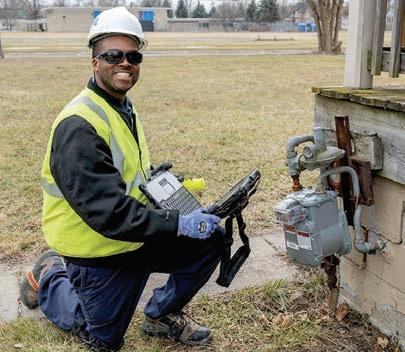
It’s
•
• Consider
•
•
Install carbon monoxide detectors on a wall or ceiling near all sleeping areas in your home to detect the presence of carbon monoxide.
• Keep the area around your heating equipment clean and don’t let storage or your belongings block airflow.
• DTE technicians and our contractors must be able to easily access your meter to perform periodic safety checks and routine maintenance, or critical tasks in an emergency. Keep a clear path and avoid blocking the meter with walls, decks or fencing.
• Further decrease the risk of carbon monoxide in your home by trimming tall grass, weeds and greenery around your meter and natural gas exhaust and intakes.
• Don’t hang objects on natural gas lines. Most importantly, if you suspect a natural gas leak, leave the area immediately, go to a safe area where you no longer smell natural gas, and call 9-1-1 before calling DTE at 800.947.5000. Learn more natural gas safety tips at dteenergy.com/ gassafety.
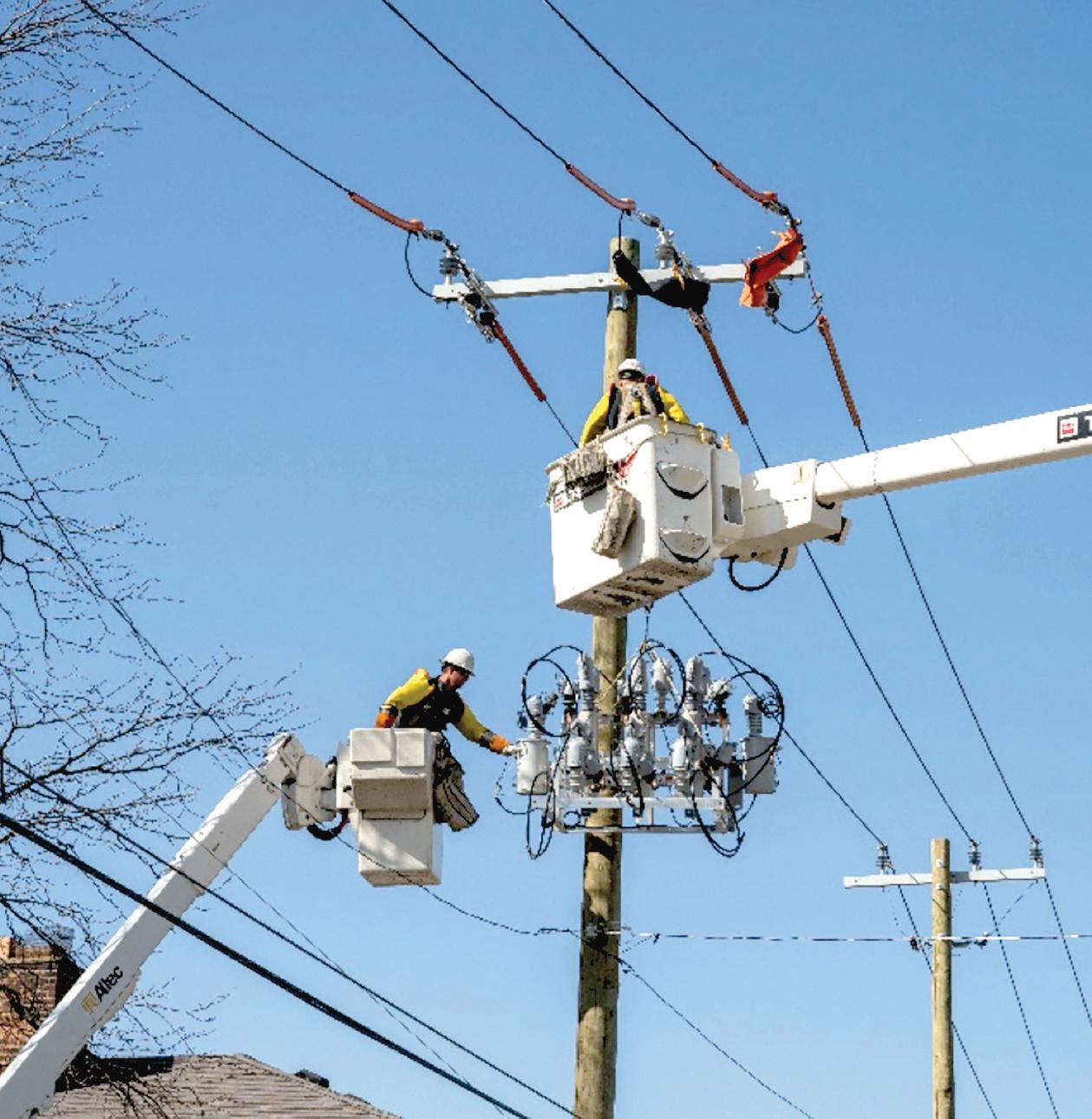

The DTE Energy Foundation is inviting nonprofits across Michigan to submit project proposals for a grant that will support community transformation efforts as part of the Foundation’s Community Empowerment Awards program. $150,000 will be shared among the winning nonprofits.
Project proposals up to $50,000 are being accepted now through 5 p.m. on Friday, May 16 on DTEFoundation. com.
“Transforming communities is a cornerstone of the DTE Foundation’s mission, with a focus on enhancing lives, meeting community needs and fostering vibrant neighborhoods,” said Rodney Cole, president, DTE Foundation. “We are thrilled to offer the Community Empowerment Awards for the second year. Last year’s responses highlighted a significant need for continued support in this area, and we are committed to addressing that need.”
Last year, five Detroit-based nonprofits received grant funding through the program, including The Konnection, Steen Foundation Inc., La Casa Guadalupana Corp., Better Way Detroit and All Things Women Inc.
The DTE Foundation transforms underserved and disinvested communities by enhancing safety, expanding positive opportunities, and providing
supportive services for youth and families. Funding supports organizations and initiatives that focus on placemaking, positive family development and community-driven solutions. Grants will be considered when meeting the following criteria:
• Applicants must be legally established 501(c)(3) public charities by the Internal Revenue Service and have the capacity to directly receive and manage the grant to be eligible.
• Fiduciary, fiscal sponsor payment arrangements and Type III supporting organizations are not eligible.
• The organization must be located in and directly benefit a project in Michigan.
• The DTE Foundation must be the majority contributor to the overall project.
• Submitted projects cannot be energy-related
•
•
•
By Kim Trent CONTRIBUTING WRITER
The teen group of the Detroit Chapter of Jack and Jill of America, Inc. recently participated in two activities designed to celebrate Detroit’s Black entrepreneurs and inspire teens to become Detroit’s Black business owners of the future.
On April 12, members of the teen group participated in a Pitch Competition where they made business pitches to a panel of high-profile business experts who served as judges. The teens were asked to create business ideas that were designed to draw teens to downtown Detroit. The teens’ pitches integrated rigorous research, impressive creativity and polished and engaging presentation.
The first-place winning team, which named themselves “Girl Power,” pitched the creation of a pier entertainment complex that would bring retail outlets, restaurants, and attractions to Detroit’s riverfront. “Girl Power” consisted of ninth graders Karis Gaston and Riley Jeffries and 11th grader Kya Woods. The team won gift cards and an opportunity to share their idea with Njia Kai, who is the Founder and CEO of NKSK Event + Production and a special event producer responsible for many of downtown’s signature events.
The second-place team, who called themselves “Team Winners,” pitched solar-powered pods that pedestrians could use to warm up when visiting downtown Detroit during frigid weather or cool down during blazing heat. The pods would generate money with digital advertising displays. Team Winners’ members were high school seniors Bryce Byas and Sion Hurst and freshman Xavier Grace.
The third-place winner pitched a wellness business that would offer patrons opportunities to create DIY skin care products with ingredients that address specific wellness needs, such as natural mood elevator peppermint oil and natural stress reliever lavender oil. Jackson Coleman, a high school junior, pitched the project solo.
The event drew high-profile judges in the entrepreneurial space, including Michigan Founders Fund Executive Director Rishi Moudgil, serial entrepreneur Sebastian Jackson and Milestone
By Ebony JJ Curry
SENIOR REPORTER
Hope doesn’t cost a thing. Education often comes with a price that feels unreachable. Across Michigan, one form has continued to determine who gains access to the resources that make higher education possible. FAFSA remains the key. Michigan has responded with something different this time—something direct. The state has introduced the Ticket to Tuition sweepstakes, offering real financial support for those who complete the FAFSA for the 2025–2026 academic year.
Ten winners will receive $50,000. Forty more will walk away with $10,000. The funds will be placed into Michigan Education Savings Program (MESP) accounts and can be used for any qualified education expense. High school students, returning adult learners, and first-time college-goers who complete the FAFSA will become eligible. To enter, applicants must text “CASH” to 1-855505-8425 and fill out the follow-up form. They can also enter by mail. All entries must be submitted by May 16.
Governor Gretchen Whitmer made the appeal simple. “I encourage all high school seniors who want to go to community, private, or public college to fill out their FAFSA, save thousands of dollars while attending school and enter to win our sweepstakes.”
This initiative connects directly to Michigan’s broader education and workforce plan. State leadership has set a goal: 60% of working-age residents with a college degree or skills certificate by 2030. At this moment, the rate stands at 51.8%. Raising that number holds serious weight. Michigan’s workforce is shifting. Jobs tied to a high school diploma alone have become scarce. Skilled trades, tech, healthcare, and education require credentials that demand additional education. The pipeline has slowed. Without serious intervention, the consequences will continue to show up across local economies.
About 53.4% of the high school class of 2024 enrolled in college within six months of graduation.
Growth Capital Institute CEO Dawn Batts, who is a mother member in the North Oakland-Macomb Chapter of Jack and Jill. Jeff Ponders, a Principal at Invest Detroit, and Justin Turk, entrepreneur and CEO of material management company Livegistics, provided coaching support to the pitch groups leading up to the Pitch Competition event.
“We were so pleased to attract top-notch judges and coaches for this inaugural event, which we hope to make annual,” said Kim Trent, Lead Teen Advisor for the teen group of Jack and Jill Detroit.
“The moms and teens who planned this event did an outstanding job of integrating Jack and Jill’s leadership and financial programming goals into an activity that that the teens really enjoyed.”
The event was organized by Jack and Jill Detroit moms Vikki Brown, an entrepreneur whose businesses include a Chick-Fil-A restaurant franchise in Livonia; Khalilah Burt-Gaston, executive director of the Song Foundation, and Dr. Aliya Courtney Hines, a dermatologist and Associate Professor at the Wayne State University School of Medicine.
The Detroit Jack and Jill Detroit teen group also participated in a Downtown Detroit Black Business Scavenger Hunt on Sunday, April 6. During the activity, members of the teen group were given clues to identify businesses with connections to Black entrepreneurs in downtown Detroit. The teens launched their hunt from a downtown loft that is owned by developer Christopher Jackson, whose sons Christopher and Matthew are graduates of Jack and Jill Detroit teen group. Jackson’s loft – which he rents out as an Airbnb property - served as an example to teens of the power of passive income.
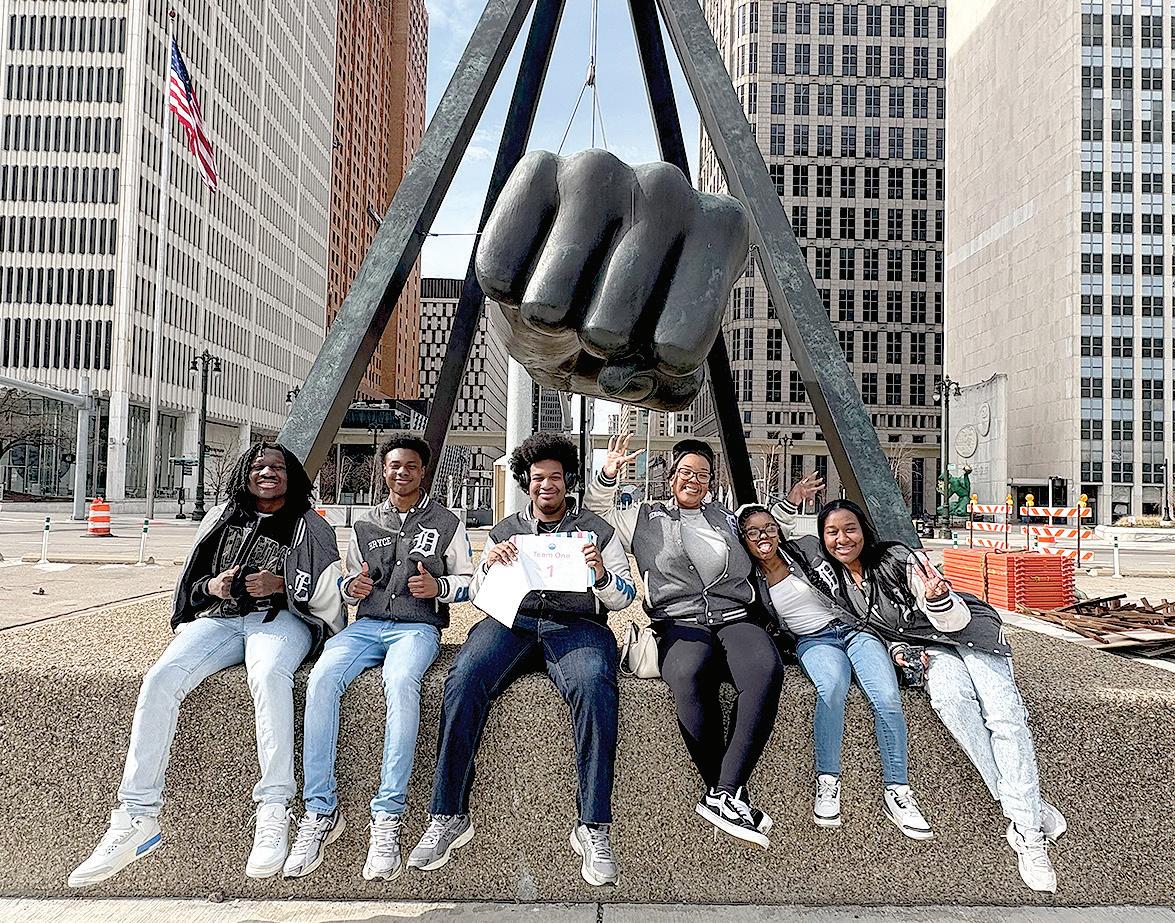
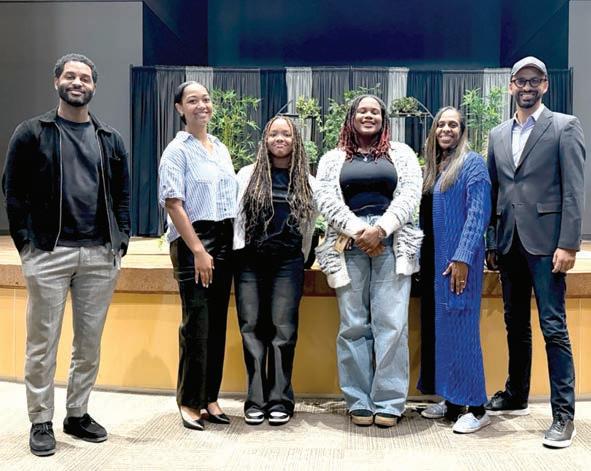
aire entertainer and entrepreneur
The teens also visited Black landmarks including the Paradise Valley Walk of Fame and a plaque that commemorates Thomas Parker’s purchase of downtown property after the fire of 1805. Parker was one of Detroit’s first Black landowners.
The scavenger hunt ended at the memorial statue honoring famed boxer Joe Louis at the intersection of Woodward and Jefferson Avenues. The winning scavenger hunt members were high school seniors Bryce Byas, Rhyes McKenzie and Emerson Tatum; juniors Jackson Coleman and Kennedy King and freshman Mye Copeland. Young men on the scavenger hunt’s winning team received cufflinks from Hot Sam’s as a prize. Young women on the winning team received products from The Lip Bar.
“While people think downtown Detroit is dominated by billionaires like Dan Gilbert, there are plenty of Black-owned businesses downtown, offering a variety of services and attractions,” said Jack and Jill Detroit teen president Sion Hurst. “It was fun to explore the Black side of downtown.”
From there, the teens were challenged to find businesses in the Paradise Valley district, including the headquarters of Real Times Media, publisher of the Michigan Chronicle. Real Times is owned by Hiram Jackson, another former Jack and Jill Detroit father. Other Paradise Valley stops included 1442 Ventures, which is owned by serial entrepreneur Dennis Archer, Jr., whose son is a high school junior in the Detroit Jack and Jill teen group; Spectacles, a retail shop that has been owned by Zana Smith since 1984; Hamilton-Anderson Associates, a multidisciplinary design firm led by Rainy Hamilton Jr. and Fixins Soul Kitchen, a restaurant owned by former NBA star and Sacramento Mayor Kevin Johnson.
Other stops on the tour included Hot Sam’s clothing store, owned by Tony Stovall and Cliff G. Green; Heritage Optical, owned by George Barnes; One Mike, an entertainment venue owned by comedian Mike Epps; The Lip Bar, owned by Melissa Butler; Woodhouse Spa, owned by Cheryl Hudson and Savage x Fenty, a lingerie store chain owned by billion-
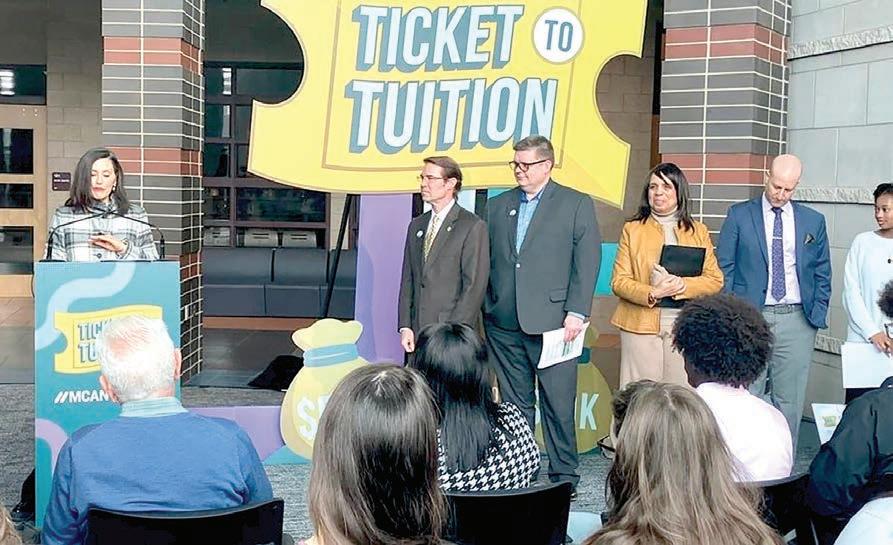
That number reflects a drop from 62.2% in years before the pandemic. Students from low-income households and first-generation families carry the most barriers. The gap has not closed. Aid exists, but too often, access sits behind complicated paperwork.
The FAFSA remains one of the most misunderstood and underutilized tools for unlocking opportunity. Many students avoid the form entirely. They hear it’s difficult, or they run into challenges gathering tax documents and income statements. Others complete the form but struggle to fix errors or access follow-up information. The federal government attempted to simplify the process last year. Instead, technical delays and submission issues added new frustrations.
Michigan’s investment in education stands strong. The state spent approximately $375.4 million during the 2023–2024 school year to support students across all state-funded aid programs. That support reached 117,336 students.
To unlock that money, students must first complete the FAFSA.
The form acts as a gateway to federal grants, state aid, and scholarships. It also determines eligibility for subsidized student loans and work-study programs.
Many students qualify for the
Michigan Achievement Scholarship once their FAFSA is submitted. That support includes tuition-free access to community colleges across the state. Students who meet income guidelines may also receive funding to attend a public university or private college. Adults returning to college through Michigan Reconnect—an initiative for residents aged 25 and older—also become eligible after completing the FAFSA.
So far, nearly 51,000 students in Michigan have submitted their forms for the upcoming academic year. That number represents about 43% of this year’s high school seniors, according to the National College Attainment Network’s FAFSA Tracker. These efforts, while impactful, still leave thousands unaccounted for.
Last year, more than 7,300 students entered a FAFSA-related campaign that offered free pizza. The incentive created some buzz but didn’t drive significant longterm change. State officials recognized that deeper investment was needed. Direct cash prizes could shift momentum where previous attempts failed to land.
The Michigan College Access Network is working closely with the state to deliver $900,000 in total prize money. The Ticket to Tuition sweepstakes has become
one of the most visible components of the broader statewide effort to re-engage students and remove barriers to enrollment.
Lawmakers have also explored more permanent measures. One legislative proposal aimed to make FAFSA completion—or filing an opt-out form—a requirement for high school graduation starting with the class of 2028. That bill did not advance, but the debate confirmed the growing consensus around FAFSA as a critical gateway rather than an optional step.
FAFSA itself does not bind students to loans. Completing the form does not obligate them to borrow money. The form simply opens access to need-based financial aid. Schools and programs use the information to determine how much assistance each student qualifies for. Once awarded, families can choose what to accept.
The research surrounding financial incentives paints a complicated picture. Lottery-style programs often lead to one-time actions. Filling out a form becomes more likely when cash is involved. What remains unclear is whether these same programs drive longterm behavior. Enrollment and retention require more than a single incentive. Still, this approach aims to remove the first and most
Founded in 1938 with a Detroit chapter that was chartered in 1953, Jack and Jill of America Inc. is a membership organization of mothers with children ages 2-19 that is dedicated to nurturing future African American leaders by strengthening children through leadership development, volunteer service, philanthropic giving and civic duty.
common barrier: starting. Students across Michigan— from Marquette to Muskegon, from Benton Harbor to Detroit— deserve access to education without fear of debt or confusion. Many of them come from communities that have been historically excluded from economic mobility. For them, this sweepstakes offers more than a prize. It extends a hand. It signals that someone sees their potential and is willing to invest in their future.
Michigan cannot wait for things to shift on their own. The economy won’t slow down. The cost of living won’t reverse. Families need real options. FAFSA stands at the center of those options. Ticket to Tuition aims to make that first step more accessible and more rewarding.
Students do not need to pay to enter. They do not need to apply for admission before filling out the FAFSA. They do not need perfect grades or a polished resume. What they need is the decision to show up—to fill out one form and take one step forward.
Every entry into this sweepstakes becomes an act of possibility. Education still transforms families. It still builds wealth. It still opens doors that stay shut without it.
The deadline to enter is May 16. The form can be filled out online or on paper. The sweepstakes form arrives by text after students submit FAFSA and text the word “CASH” to 1-855-505-8425. That number is worth writing down. The opportunity is worth claiming.
Michigan has placed a bet—not just on numbers but on people. On students who have been told education costs too much. On adults who never thought they’d go back. On communities that have waited too long to be heard.
The Ticket to Tuition doesn’t promise overnight change. It provides a tool. It brings clarity to a process that often feels clouded. It gives families one more reason to take that first step: to believe they belong and to know someone is backing their journey.
A5 | April 23-29, 2025
In the quest for economic empowerment and generational wealth, Black women are boldly leading the way in homeownership, significantly outpacing Black men and other demographics in recent years.
According to the 2024 Snapshot of Race and Home Buying in America by the National Association of Realtors, single female homebuyers are most prevalent among Black women, making up an impressive 27% of all Black homebuyers. By comparison, single women represent 24% of Asian homebuyers, 17% of white buyers, and only 7% of Hispanic buyers.

Digging deeper into recent data, a 2023 Realtor.com analysis highlighted the growing trend even further: between October 2017 and September 2018, Black women constituted 32.4% of Black homebuyers a figure that rose to 35.4% between October 2020 and September 2021. The momentum is undeniable; from October 2018 to January 2020, the number of Black female homebuyers grew at an average annual rate of 7.3%, more than double the growth rate of 3.4% among Black men during the same timeframe.
Yet, despite their remarkable strides, Black women face numerous systemic hurdles. Arlita Harvey, a seasoned realtor with Alite Realty, sheds light on this stark reality: “There are instances where Black women are successfully buying homes, but it doesn’t mean the path is easy or free from unnecessary barriers created by societal challenges that simply shouldn’t exist.”
Historically, Black women have been foundational pillars in their communities, providing stability, raising families, and significantly contributing to societal growth. Their commitment to homeownership underscores their understanding of the transformative power property holds not just for themselves but for future generations. We must recognize and honor this determination by actively working to reduce the barriers that complicate their path to homeownership.
The truth is clear: Black women are driving community growth, improving educational opportunities, and nurturing the next generation. It is imperative that access to homeownership becomes easier and more attainable for them. Often, buying is more affordable than renting making homeownership not only desirable but economically wise.
Property is power, and when Black women thrive, entire communities flourish. Let’s continue to advocate for policies and practices that support and simplify the journey toward homeownership for Black women. After all, when we lift barriers, we empower not only individual buyers but also the broader community they sustain and enrich.
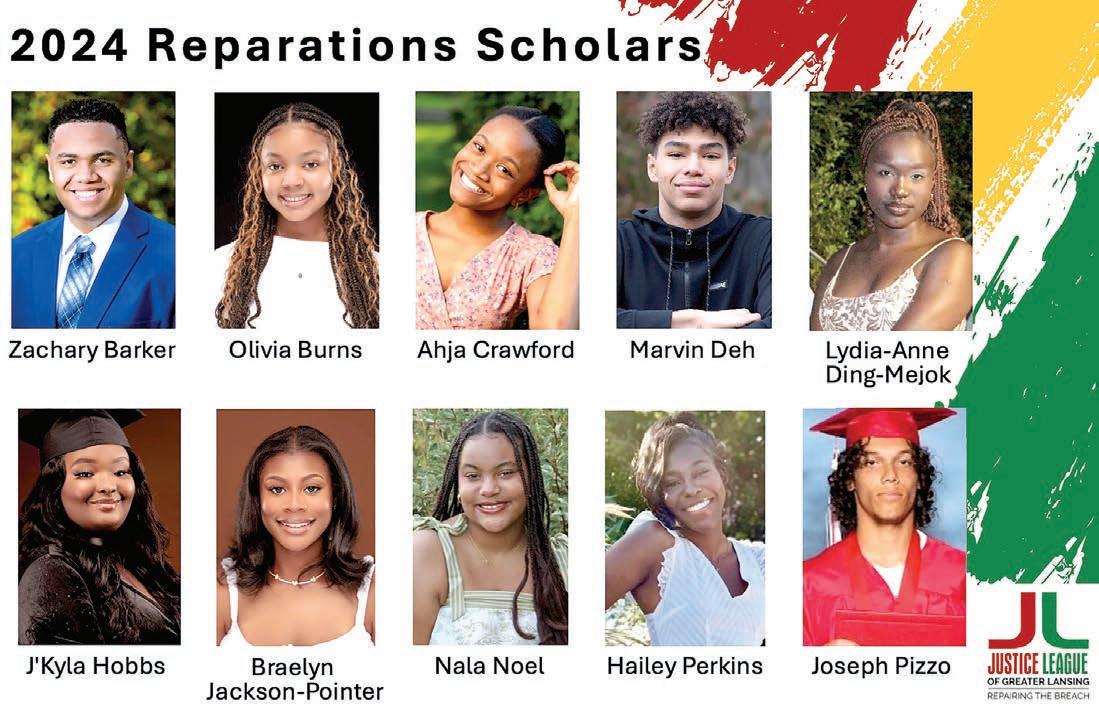
By Ebony JJ Curry SENIOR REPORTER
Some stories don’t fade with time—they call us to act. The call-in Lansing is clear: it’s time to repair the breach. Through ten $2,500 Reparations Scholarships, the Justice League of Greater Lansing, Michigan is answering that call with purpose and precision.
This isn’t a focus on performative equity. This is an investment in futures that have long been deferred. Applications are now open for the Justice League’s second annual Reparations Scholarship essay contest. Each award is rooted in acknowledgment, action, and access— backed by a growing fund built primarily by reparations payments from faith-based institutions that have named their historical complicity.
Graduating high school seniors in Ingham, Eaton, and Clinton counties still qualify, but a significant shift is meeting the moment: nontraditional students are now eligible. That means individuals who have earned a GED, completed high school in previous years, or finished vocational training programs can apply. The expansion opens a pathway for learners who didn’t follow the traditional route but carry the same burden of generational loss.
Prince Solace, president of the Justice League, described the intention behind that move. “The Justice League Advisory Council members want to make the program more accessible to and inclusive of
Sponsored by JPMorganChase
Whether you’ve just started your journey to financial health or are well on your way to reaching your financial goals, you’ve likely heard about the critical role investing plays in financial health.
While this is sound advice, you may have lingering questions about how to construct an investment portfolio or whether certain times are more opportune for investing. You might also be curious about whether you should focus on specific types of investments, such as stocks or bonds, or explore real estate and other commodities.
There isn’t a one-size-fitsall answer. While some strategies can benefit nearly all investors, your investment choices should align with your future financial plans – both short-term and longterm.
often includes an array of asset classes such as equities, or stocks, representing ownership stakes in corporations; fixed income securities including bonds, and tangible commodities like precious metals or agricultural products. Investors often view their investments as a whole through their portfolio to track their progress.

Here, Erik Merchant, Michigan Head of Investments & Advice for J.P. Morgan Private Bank, shares four key strategies for building your investment portfolio and how to get started: Learn what makes up an investment portfolio
Begin by familiarizing yourself with what an investment portfolio entails. A portfolio is a collection of investments that
Assess your risk tolerance Investment strategies are not universal. If your goal is to minimize risk and preserve your principal investment, consider a conservative portfolio with assets like bonds, which can be less prone to significant losses. Although a conservative portfolio could yield lower returns, it may be suitable if you’re nearing retirement and will need your funds soon—or if you simply prefer to minimize risk.
Conversely, a high-growth portfolio involves investing in higher-risk assets that can yield more substantial gains or losses. While it’s often recommended that younger people invest more aggressively since they have more time to recover from potential losses, it’s more about how soon you hope to achieve your investment goals.
You might opt for a balanced approach, diversifying your investments across multiple asset classes.
their community,” he said. “The Reparations Scholarship Program is a cornerstone of our efforts to mend the historical injustices stemming from slavery and its lasting impact.”
This scholarship is not an act of charity. It is a vehicle of economic justice. It is a faith-based response to a historical sin—slavery—and the multi-generational fallout that followed. Solace made the goal unmistakably clear: “Educational empowerment for descendants of enslaved African Americans fosters a future where racial justice and faith converge to support academic achievement. Offering financial assistance is essential for enabling access to that higher education.”
Applications are due Friday, May 9, 2025. Each applicant must be a resident of Ingham, Eaton, or Clinton County. They must begin their studies at an accredited college, university, or trade school in the fall of 2025. And they must be a descendant of an enslaved African American.
That last requirement holds more weight than a checkbox. It carries with it the truth of America’s foundational contradiction—liberty for some, bondage for others. The Justice League defines descendants of enslaved Africans as individuals whose lineage includes three generations born in the United States: the applicant, a parent, and a grandparent. It is a working definition rooted in what’s often the only history Black families can access—
oral testimony. Solace addressed that reality directly. “Most Black adults in the U.S. are descendants of enslaved African Americans—well over 80% per U.S. Census Bureau 2020—and learn of their history through family stories,” he said.
This inability to trace family lineage is not an accident—it’s an outcome of state-sanctioned erasure. Enslaved Black people were not recorded by name prior to 1870. Their humanity was reduced to numbers in slave schedules, and their existence was treated as inventory. This deliberate denial of identity makes lineage difficult to prove on paper but impossible to deny in truth.
“The ‘three-generation’ definition helps students quickly determine eligibility. Their families have felt the detriments of systemic and structural racism that are the aftermath of the sin of slavery,” Solace said. “This has prevented them from building generational wealth and hits to the core of our mission.”
The scholarship application includes a 500-word essay. This is where the statistics meet storytelling. Applicants are asked to write about how the racial wealth gap or generational wealth in America has affected their family. It’s not just an exercise in reflection—it’s a statement of lived reality. An opportunity to put into words what it means to move through life with the weight of historical theft on your shoulders.
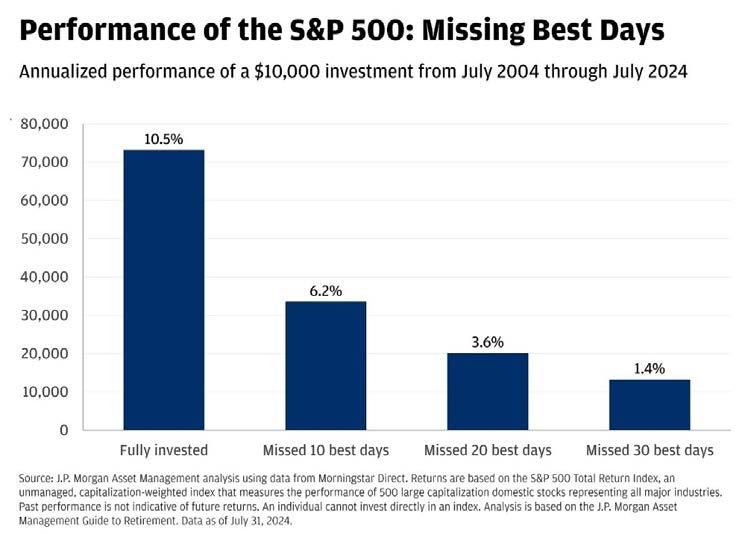
Diversify your portfolio Plan to distribute your investments across different types of securities. For example, avoid concentrating all your money in a single stock, as a downturn in that stock could jeopardize your entire portfolio.
It’s also recommended not to put your money solely in one asset class (for example, just stocks) – instead, it’s generally better to spread your investments across different types of securities with different levels of risk.
This approach can help protect your money. For instance, you have money invested in several asset classes like bonds, stocks and commodities, and the bond market falls, only part of your investment portfolio will be affected.
Think long-term, no matter your goals Regardless of strategy and allocation, it’s generally advisable to maintain a longterm perspective, as this allows for the compounding of returns and the ability to weather short-term market fluctuations. For investors, maintaining a long-term mindset can pave the way for success. Although markets can always have a bad day, week, month or even year, history suggests investors are less likely to experience losses over longer periods—especially in a diversified portfolio.
Reacting with fear during market downturns and withdrawing your investments could mean missing out on potential rebounds, which is why investors should focus on time in the market, not timing the
From page A-5
The reparations initiative itself was born from a collective reckoning. The Justice League of Greater Lansing, Michigan, formed in 2021 with a mission to confront the racial wealth gap head-on. This is not theoretical. This is local. This is Greater Lansing naming its role in a national wound and organizing through policy, education, and faith to stop the bleeding.
Their work is underpinned by a faithbased model of reparations. That’s not a vague spiritual gesture—it’s a financial commitment. Churches contributing to the Reparations Fund are not simply issuing statements of support. They are acknowledging that their institutions benefited from white supremacy and are committing resources to help repair what was broken.
Solace made the foundation of the Justice League’s work clear: “Reparations are in the spirit of repentance for the sin of slavery, its aftermath of gross human rights violations—including genocide, violence, land theft, incarceration and police violence— and complicity in the misbelief of white supremacy.”
Through that lens, scholarships are not handouts. They are installments in a long-overdue debt.
Beyond education, the Justice League’s broader mission includes supporting home ownership and entrepreneurship. But they’ve prioritized education because it’s a tool of liberation. And for Black Americans—especially those whose families were intentionally locked out of wealth-building for generations—education remains one of the most direct paths to mobility and restoration.
Solace’s framing matters. He isn’t asking for sympathy. He is demanding systems-lev-
el acknowledgment and structural correction. The organization’s Reparations Fund reflects a practical model for others to adopt. This is how equity can be built—not by slogans but by sustained and intentional reinvestment in those most impacted by centuries of harm.
For those looking to apply, the full application process is hosted at JusticeLeagueGLM.org/apply. Entries can be submitted digitally or mailed. A downloadable flyer is also available to help applicants and community partners spread the word. Every detail has been designed to center accessibility and remove barriers, not erect them.
The Justice League is also laying the groundwork for what long-term accountability looks like. They are not operating from a moment of guilt or performance. This work is steady, intentional, and rooted in relationships. The partnerships between churches, community stakeholders, and applicants are built on transparency, truth, and trust. That model is worth replicating.
Ten students will receive $2,500 each. That is $25,000 directly into the hands of those who represent the descendants of this country’s original unpaid labor force. But more than that, it’s the kind of action that builds momentum. It disrupts cycles. It moves reparations from theory to practice.
This is how justice breathes—through policies that see people, through funds that acknowledge harm, through programs that refuse to let another generation be forgotten or left behind.
This time, ten young minds—or perhaps returning adult learners—will carry that torch forward. Because repair is not a favor. It’s a right. And it’s already underway in Greater Lansing.
From page A-5
market. Over the last 20 years, seven of the 10 best days occurred within 15 days of the 10 worst days.
The bottom line
With an understanding of what it takes to build your portfolio, now is the time to get started! You can open a brokerage account online at any time and you can connect with a financial advisor in person to learn more about investing products, so you can build the right portfolio for your financial needs and goals. For informational/educational purposes only: Views and strategies described in this article or provided via links may not be appropriate for everyone and are not intended as specific advice/recommendation for any business. Information has been obtained
from sources believed to be reliable, but JPMorgan Chase & Co. or its affiliates and/ or subsidiaries do not warrant its completeness or accuracy. The material is not intended to provide legal, tax, or financial advice or to indicate the availability or suitability of any JPMorgan Chase Bank, N.A. product or service. You should carefully consider your needs and objectives before making any decisions and consult the appropriate professional(s). Outlooks and past performance are not guarantees of future results. JPMorgan Chase & Co. and its affiliates are not responsible for, and do not provide or endorse third party products, services, or other content.
Deposit products provided by JPMorgan Chase Bank, N.A. Member FDIC. Equal Opportunity Lender. © 2025 JPMorgan Chase & Co.


For more than 100 years, Barton Malow has been committed to building People, Projects, and Communities. With team members and trade partners strategically positioned across North America, we are on a mission to transform the construction industry through innovation and increased efficiencies in the building process.

bartonmalow.com
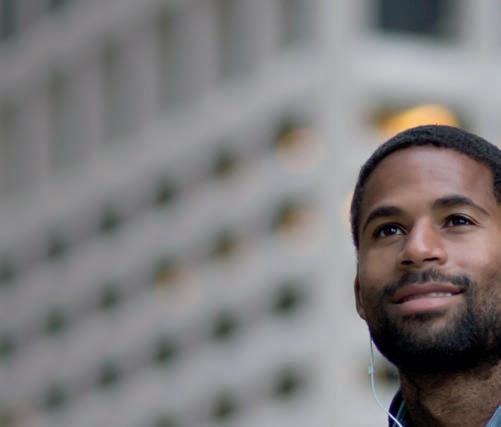





By Adam Hollier
SUBMITTED SPECIAL TO MICHIGAN CHRONICLE
One of the first lessons I learned was when you get knocked down, you get back up again.
It’s what our parents instill in us. It’s what I heard time and again serving our nation in the United States Army.
It’s what we as Detroiters do every single day.
Last year, I ran for Congress. It was a lifelong dream - and I was so proud of the campaign we built and the support we received from every corner of this community. And then, at a critical moment, I screwed up. I trusted someone to help collect our signatures to get on the ballot - and that person let me down.
It hurt, especially because of all the people I let down. But no matter how low I felt, I knew there was still work to be done. And so I took the hardest step possible, the first step, out my front door and back into the community.

I knocked on doors and visited churches. I walked our blocks and talked to neighbors on their porches. I worked to help elect Democrats around this city - but more importantly, I listened.
I listened to people share their dreams - many of which had been crushed, delayed, or deferred. I heard about their fears and the hopes that kept them going every single day. And everywhere I went, I heard people say another thing: “Adam, don’t stop. Don’t give up. We’re with you.”
That meant more to me than anyone can imagine, and I knew I owed it to them - and to this community - to get back in the fight.
I’m running for Congress. And nothing will stop me from fighting for you.
Because here’s the thing: We face huge problems right now across our community. People can’t afford their homes. Or daycare. They can’t afford the rent. Hell, they can’t even afford to get the brakes replaced on their cars - let alone dream of buying a new one. And rather than doing anything to fix it, our multi-millionaire Congressman Shri Thanedar is spending hundreds of thousands of your hard-earned tax dollars putting up self-portraits of himself all over town.
That’s something only Donald Trump and Elon Musk would be proud of.
We need bold solutions and leaders who won’t back down in the face of this crisis. The last thing we need are more millionaires and billionaires like Elon Musk and Shri Thanedar who are only in it for themselves.
And that’s why I’m running.
I’m running because we can build more affordable homes. We can invest in daycare and transit that actually gets people to and from work. We can create jobs and lower costs. We can tackle gun violence and protect our immigrant communities. We can safeguard a woman’s right to choose, fight back against bullying of our LGBTQ+ friends and family, and send a loud and clear message to Donald Trump, Elon Musk, and all the millionaires who are screwing over our neighbors:
We aren’t afraid, we aren’t backing down, and we’ll never give up.
That’s what this community is all about. It’s about perseverance. It’s about grit. It’s about getting back up and dusting yourself off…and keeping your eyes fixed on the future. And then fighting like hell to build that future for everyone.
I hope I can earn your support. Adam Hollier
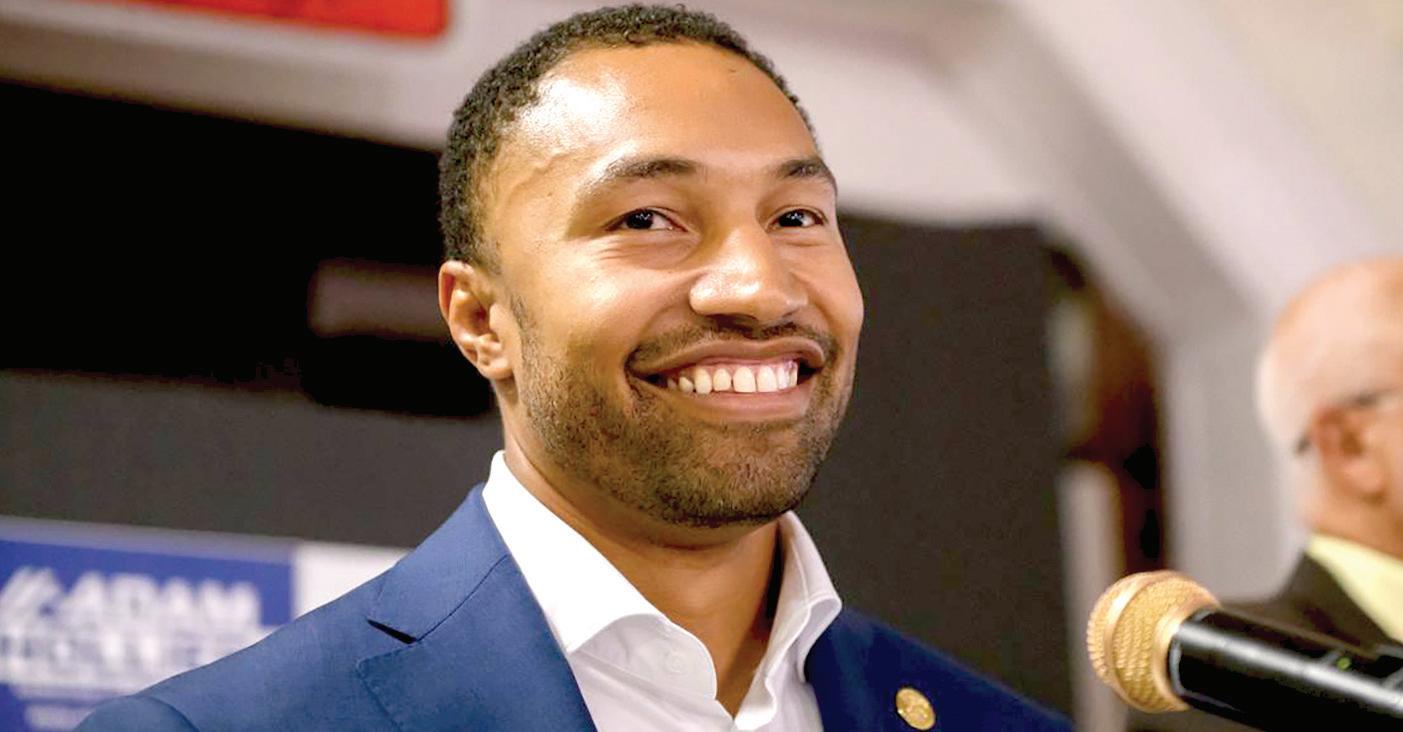
By Ebony JJ Curry SENIOR REPORTER
Detroit doesn’t always cheer for comebacks until they’re complete. But anyone raised on the pulse of 7 Mile or the echo of the gospel from Sunday morning pews knows that rising again isn’t a weak man’s game—it’s a Detroit tradition. Aaliyah said it best: “If at first you don’t succeed, dust yourself off and try again.” For Adam Hollier, that’s not just lyrics. It’s marching orders.
Adam Hollier has stepped back into the arena. Monday morning, the former Michigan State Senator and Army officer made it official—he’s running for Congress in Michigan’s 13th District. A seat currently held by multimillionaire Rep. Shri Thanedar, who’s been criticized repeatedly for turning public office into a stage for personal branding. Hollier’s campaign, though, brings with it a different rhythm. One that moves with service, transparency, and urgency for a district that’s seen promises broken before.
“From housing to daycare to the rising costs of everything from groceries to the brakes on our cars, we’re in a real crisis in this country,” Hollier said. “We need bold solutions and leaders who won’t back down in the face of this challenge. The last thing we need are more millionaires and billionaires like Elon Musk and Shri Thanedar who are only in it for themselves.”
That statement isn’t hollow. Thanedar has recently come under fire for spending nearly $1 million of taxpayer money— funds intended to serve the people—on promoting his own image. Self-portraits. Vanity campaigns. Public resources are used not for relief or reform but for recognition. Hollier didn’t pull punches: “It’s absurd. While everyday Michiganders are struggling, Shri Thanedar is spending hundreds of thousands of their hardearned tax dollars putting up self-portraits of himself all over the district. That’s something only Donald Trump would be proud of.”
For those unfamiliar with Hollier’s last run, it’s worth remembering. The record speaks with both ambition and adversity. In 2022, he sought the same seat. After a close loss in the Democratic primary, where he built strong traction across Detroit, Highland Park, and Hamtramck with endorsements like the Congressional Black Caucus PAC, Hollier tried again in 2024. That bid ended before ballots were cast. His campaign was disqualified after submitting fraudulent petition signatures, halting his momentum. Now, in 2025, he returns for a third run—not with excuses, but with determination and a renewed call to serve the district he still calls home.
This marks his third campaign for
elected office in a decade—and each one has been about serving the place that shaped him. Hollier was born and raised in Detroit. His family’s history is sewn into the fabric of the city. His father, Carl, was a union firefighter—literally running toward flames when others stepped back. His mother, Jacqueline, was a social worker who leaned into people’s pain when others turned away. His grandmother brought their family to Detroit from the Muscogee Creek reservation in Oklahoma, chasing the promise of better. That same grandmother descended from a great-grandmother who was forced from Georgia to Oklahoma during the Trail of Tears. These aren’t just ancestors. They’re blueprints.
Now raising his own children—Lily and A.J.—with his wife Krystle, Hollier continues that tradition of service. He’s a proud graduate of Detroit Public Schools, a member of the American Federation of Teachers Local 6075, and a veteran who serves as team chief and paratrooper in the Army Reserve. Not the kind of leader who waits for things to be safe—Hollier trained to jump out of planes. He volunteered as a firefighter after Katrina. He’s always chosen proximity to pain over distance from responsibility.
This reentry into congressional politics is built on more than memory. Hollier brings receipts. As a State Senator, he delivered over $40 million to his district for job training, business development, and community advancement. He fought for lead pipe replacement, pushed for fair election maps, and stood for LGBTQ+ rights. When one of the district’s largest employers prepared to shut down an auto plant, Hollier worked side by side with UAW leadership to reimagine it as Factory Zero—a cutting-edge electric vehicle plant providing local jobs for the future.
That experience sharpened his understanding of what the government must do beyond speeches. His campaign promises are rooted in the realities Detroiters speak about every day. He’s calling for federal and state investment in affordable housing, aggressive accountability for corporations that inflate costs for renters and families, and a repeal of tariffs driving up prices for everyday goods. “We keep fighting,” Hollier said. “That’s why I’m running—and that’s the same fight that I’ll bring with me to Congress every single day.”
After his term in the State Senate, Governor Gretchen Whitmer appointed him to lead Michigan’s Veterans Affairs Agency. There, Hollier helped double the state’s veterans database, expand job programs, and address homelessness and suicide rates among Michigan’s service members. That work wasn’t symbolic. It meant real policy shifts, real funding, and real lives impacted.
To understand the cultural weight of this campaign, though, you have to understand the district. Michigan’s 13th District is nearly 55 percent Black. It includes the heart of Detroit and cities like Highland Park, where disinvestment has been deep, and community needs run long. It’s a district where representation has often been symbolic without substance. Hollier is running to shift that. This campaign isn’t a redemption story. It’s a resistance story. Resistance to the erasure of working-class voices by billionaire-funded politics. Resistance to the normalization of self-serving leadership. Resistance to the assumption that Black Detroiters can be bought with billboards and mailers while their water, homes, and schools continue to suffer neglect. This campaign is about infrastructure that doesn’t fall apart the moment federal funds stop flowing. About business development that prioritizes neighborhood entrepreneurs, not just tech giants. About a tax system that stops penalizing the poor while rewarding the rich. About child care that is affordable and accessible for the people who make up the very backbone of this economy.
“We’re in a real crisis,” Hollier said plainly. His approach to that crisis isn’t to retreat—it’s to run straight toward it. That mindset—that sense of responsibility—didn’t start with politics. It started with his family legacy and deep community roots. It was cemented when he stood with residents in defense of their water when he showed up in Lansing not to play politics but to push policy, and when he joined the Army not for the title but because he believed in duty.
Detroit knows the difference between performance and principle. Adam Hollier is leaning into principle. And while his critics will point to this being a third attempt at a congressional seat, Hollier’s supporters see something else: a man who got knocked down and stood back up. Again.
Detroit doesn’t just survive—it adapts, it transforms, it teaches. It sends people like Hollier into battle—not for clout, but for change. His campaign is a reminder that bravery isn’t about timing; it’s about truth.
And right now, truth matters more than image.
So here we are. Adam Hollier has entered the race. Not with flash. Not with fanfare. But with fire. The kind that doesn’t burn out under pressure. The kind that knows the work is never done, especially when the people you serve are the ones most often left behind.
This district deserves a leader who knows the ground he walks on. Adam Hollier’s boots have already left their imprint. Now, he’s asking for a chance to keep marching.
By Detroit City Councilman Scott Benson, Special to Michigan Chronicle
As a pro-growth Detroit City Councilmember and an avid bicyclist, I am always looking for ways to get Detroiters employed, promote sustainable transportation and reliable, inexpensive platforms for commuting to and from work. That’s why I am proud to lead Bikes for Employees (B4E), a program that aims to promote reliable, sustainable transportation, employee well-being, and community engagement by removing barriers to access to high-quality bicycles for employees.
Over the past few years, we’ve successfully provided high-quality bikes to numerous employees and students facing transportation difficulties. We partner with employers to promote workplace cycling, offering support services to both the companies and their employees who benefit from the program. B4E operates on a simple premise: we want transportation-insecure Detroiters to have an affordable, healthy way to commute to and from work. Through the generosity of the United Way of Southeastern Michigan, the Detroit Greenways Coalition for incubating B4E through 2024, the Cultural Wellness Center, our recruiting partners, and the Trek Bicycle Corporation, we provide bicycles and gear to employees who don’t have reliable transportation or who want to switch to bicycle commuting.
We work with Detroit employers and social services agencies to identify employees or clients who could benefit from the program. Bike packages are paid in part through voluntary payroll deductions, employer wellness benefits, grants or transportation assistance funds. At our bike distribution events, we set
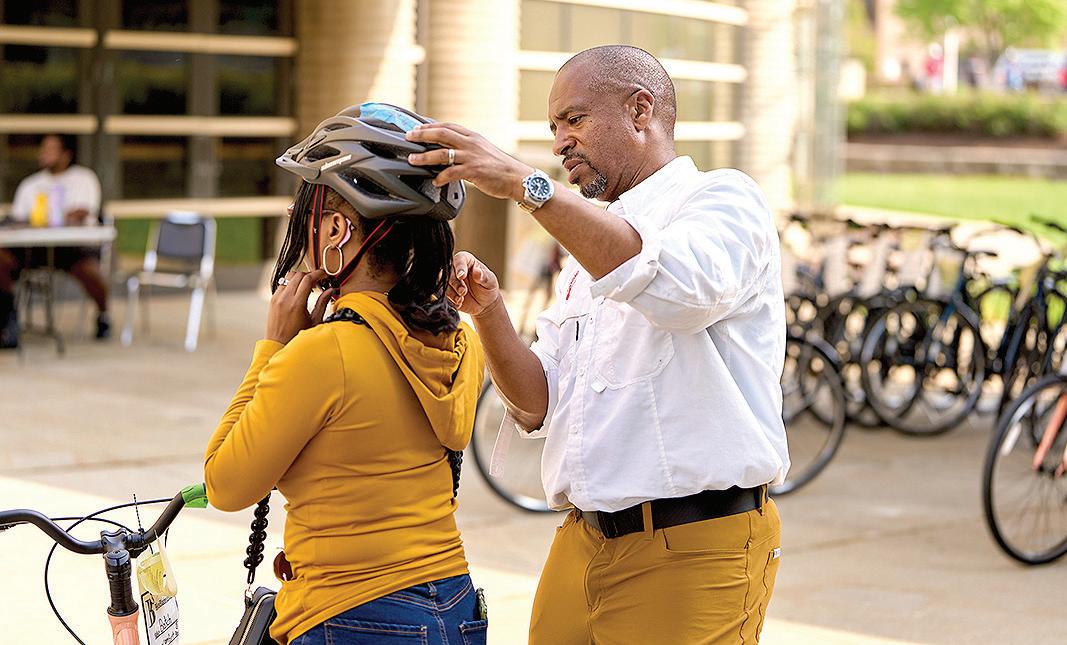
up our new bike commuters for success by providing free, hands-on training on bike safety and education, including safe cycling practices, route planning and basic bike maintenance. Our relationship with the bike commuters doesn’t end there. We continue our outreach by helping to organize company-wide or inter-company cycling challenges and events to encourage participation and build community.
This program benefits both the company and its employees. For the employer, it means reduced parking costs as demand for parking decreases. It improves employee productivity because employees who are happier and healthier tend to be more focused and productive. In 2024, 95% of our recipients reported improved health and
82% were able to get to work or school more reliably Bike commuting also helps demonstrate a company’s commitment to sustainability and employee well-being. There are also potential tax incentives for employers who support employee commuting programs. For employees, the benefits are plentiful. In 2024, 82% of recipients reported saving money by biking. These cost savings are a result of reduced expenses on fuel, parking, car maintenance, Uber/Lyft or bus fares.
Many B4E participants report better cardiovascular health, reduced risk of chronic diseases, and improved mental well-being. Cycling can be a relaxing and enjoyable way to commute, so stress is lowered. Bicycling can be a convenient transportation method, bypassing traffic congestion, especially in
urban areas. And there is also the chance to build community by connecting with other cycling employees.
B4E works closely with employers to provide everything they need. All employers must do is invite employees or clients to complete a B4E bike application, approve their list of bike recipients recommended by B4E, complete a post-program survey, and then select a method to support B4E such as voluntary payroll deductions, employer wellness benefits, transportation subsidies, general funds, or a combination of these.
The City of Detroit benefits from B4E as well. By encouraging bicycle commuting, we help transportation-insecure Detroiters get to work. We reduce our reliance on single-occupancy vehicles. We enhance the health and wellness of our residents through increased exercise which reduces stress. We promote a greener Detroit by lowering carbon emissions and reducing traffic congestion. B4E helps our employers offer a unique and attractive employee benefit that can improve morale, productivity and retention. In addition, by working with Jason Hall and Trek, we support a local business.
Recent research by the University of Glasgow in Scotland has shown that biking to work is a game-changer. A study showed that bike commuters have a 47 percent lower overall risk of early death. They are also less likely to develop heart disease, cancer, or mental health problems. The same study also looked at those who walk to work, but the health benefits to bicyclists was greater.
If you or your employer are interested in learning more about B4E, please visit B4E. bike and don’t hesitate to contact Councilman Scott Benson at 313-269-1224.

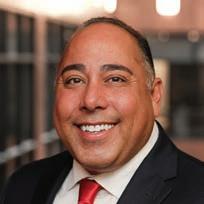

Ed Siaje President,

B1 | April 23-29, 2025
By Amber Ogden STAFF WRITER
The Detroit Institute of Arts (DIA) is once again bringing art beyond its historic walls and into the heart of Metro Detroit neighborhoods. The museum has just announced the 2025 Wayne County locations for Inside|Out, its celebrated public art initiative that places high-quality reproductions of masterpieces in everyday outdoor spaces.
Now in its 16th year, Inside|Out continues its mission of making world-class art accessible to all, transforming parks, campuses, and community centers into open-air galleries. This year, eight Wayne County communities will welcome new and returning favorites from the DIA’s collection, offering residents an unexpected artistic encounter during a walk, commute, or coffee break.
Julie McFarland, Executive Director of Public Affairs and Engagement at the DIA highlighted being honored to bring Inside|Out to communities in southeastern Michigan and connect people with the museum’s collection in new and exciting ways.
“This year, with reproductions placed across Wayne County, we hope this small representation of the collection not only brings art to people’s everyday lives but also inspires a visit to the museum,” McFarland said.
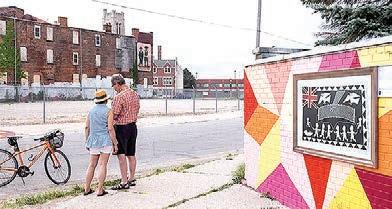
The 2025 Wayne County Inside|Out locations include:
• Schoolcraft College
• Grosse Pointe Region
• City of River Rouge
• Grosse Ile
• University of Detroit Mercy
• Charter Township of Van Buren
• Wayne Community College (all campuses)
Each site will feature a curated selection of 12 artworks, blending new highlights with classic favorites. Visitors can expect to encounter captivating reproductions of works by Van Gogh, Monet, and Degas alongside modern standouts such as The Council by Mario Moore, Saxophonist by Maria Blanchard, and Marsden Hartley’s Boat Abstraction.
To make the experience even more immersive, the DIA is introducing a revamped digital companion at dia.org/insideout.
The new interactive web pages, launching this spring, include detailed maps, artist insights, and planning tools. Each installation will feature a QR code, allowing passersby to explore nearby artworks or chart a course to see the original piece in the museum itself.
Made possible by Tri-County millage support and Ford Philanthropy, Inside|Out is more than a seasonal program; it’s a statement about access, creativity, and community. And for residents of Wayne, Macomb, and Oakland counties, the experience doesn’t have to end outdoors: free general admission to the DIA means everyone can enjoy and deepen their connection with the full collection year-round.
“Seeing art in the community is just one way we hope people will connect with our collection,” McFarland said. “With a simple scan, you’re instantly drawn into the larger story of the work, and the DIA.”
To learn more about this year’s participating communities, featured artworks, and digital tools, visit dia.org/insideout.
Admission to the DIA is always free for residents of Wayne, Oakland, and Macomb counties.
By Ebony JJ Curry SENIOR REPORTER
Every city has a heartbeat. For Detroit, that pulse reverberates from the corner where Woodward and Michigan Avenues meet—a place where memories are made, culture thrives, and resilience is on full display. That place is Campus Martius Park. And for the third straight year, the nation agrees: this is the No. 1 Public Square in America.
Detroit is not new to defying expectations. But this moment means more than a ranking. This recognition—awarded by USA Today’s 10Best Readers’ Choice Awards—is a statement. A declaration of what intentional public space looks like when it’s built for the people, by the people, and with the spirit of community at the center. Detroit has claimed this title before. But a three-peat? That says the soul of this city refuses to be overlooked.
Campus Martius Park is a history reclaimed. Built on Detroit’s
By Miss AJ Williams
When Jazzmin Pitts founded Healed Black Women in 2021, she didn’t act out of ambition—she responded to necessity. As she navigated her own healing journey in isolation, Pitts did the deep, emotional work alone. “I was facing my pain, unlearning habits, and trying to grow—but I had no support system,” she recalled. That solitude stirred a powerful longing within her—to create a space where Black women could show up fully as themselves—vulnerable, raw, and unfiltered—and receive compassion, not critique.
So, she built it.
Healed Black Women became more than a community— it became a sanctuary, a sacred place where Black women name their wounds without shame, rebuild self-trust, and reconnect with their authentic selves. Pitts rooted the organization in a core truth: emotional healing isn’t meant to be a private battle—it’s a shared, collective journey. She centered the work around emotional restoration and generational empathy, guiding women to transmute deep childhood wounds into powerful pathways of liberation.
Pitts began her own healing in a college psychology class, where she took a simple quiz on attachment theory. What started as a classroom exercise struck a deep chord. “The results were like a mirror,” she said. “I saw the guarded woman I had become—and for the first time, I understood how she got there.” That moment cracked something open. She recognized that many Black women carried similar invisible burdens—defense mechanisms rooted in unmet childhood needs and often anchored in the mother wound.
At Healed Black Women, Pitts starts at the root. She teaches women how early caregiver relationships shape emotional responses, trust, and vulnerability. Many who enter the space don’t know how to name their emotions—they’ve learned to suppress needs or question their own instincts. But through a layered process of education, emotional regulation tools, deep reflection, and collective witnessing, they begin to come home to themselves.
Today, Pitts calls herself The Attachment Healer—a title born from her own transformation and her mission to help others reclaim their inner child. She grounds her work in the practice of generational empathy—learning to see caregivers through a compassionate lens, recognizing that they, too, were shaped by wounds they never healed. “When I began to see my mother not just as the woman who hurt me, but as someone shaped by pain—it softened something in me,” she explained. “It allowed space for compassion, and that changed our relationship.”
She doesn’t excuse harm—but she does create space for understanding. And that’s where healing begins. Pitts invites others to ask themselves: “What did my caregivers believe about love? About emotions? About safety?” These questions don’t just dissolve shame—they open the door to true liberation.
Pitts doesn’t claim to have it all figured out even as a founder,


From page B-1
mother, student, and advocate. “There are moments I feel stretched thin,” she admitted. But she now listens to her body and treats self-care as essential, not optional. Whether painting, visiting a museum, resting in stillness, or laughing with her daughters—she puts herself on her own calendar. “Balance isn’t always present,” she says. “But grace? I give myself that every day.”
On July 13, Pitts will launch her debut book, Healing Your Hidden Child: From Guarded to Grounded—a soulful blend of memoir and guidebook that offers readers a map to their own healing. That same day, she will host Rhythmic Reflection: Harmony in Healing—a community gathering filled with sound healing, movement, storytelling, and wellness vendors. “It’s not just an event,” she said. “It’s an experience— meant to open the heart and awaken the senses.”
Looking ahead, Pitts is growing Healed Black Women through school partnerships, curriculum-based programs, community collaborations, and an upcoming podcast focused on emotional healing and cultural identity in Black communities. Her vision remains clear and bold: to make emotional healing not just accessible—but normalized—in Black spaces.
What could shift if more Black women felt seen, supported, and safe enough to be real?
What might change if we healed together instead of hurting in silence?
With Healed Black Women, Pitts continues to answer those questions—one story,
From page B-1
hold space—it anchored the city’s hosting spirit. The logistics were massive, but what stood out most wasn’t the scale. It was the grace. The hospitality. The authenticity that Detroiters bring every time the national spotlight turns our way.
This award, determined through public voting after a panel of subject matter experts and USA Today editors nominated contenders, is about people. Regular folks cast daily votes to name Campus Martius the nation’s best. That’s not marketing. That’s validation. That’s love. That’s a community recognizing a city that’s finally being seen for more than headlines and histories of hardship.
There’s a deeper narrative here. For decades, public spaces in Black and brown neighborhoods across the country have been stripped of investment or erased through development that ignored the needs of the community. Detroit has known that truth.

When I began to see my mother not just as the woman who hurt me, but as someone shaped by pain—it softened something in me,” she explained. “It allowed space for compassion, and that changed our relationship.”
Jazzmin Pitts
one sister, one soul at a time. This isn’t just an organization. It’s a movement, a mirror, a ministry, and a radiant reminder that we are never alone in our healing.
who stayed when it was hard, and who now dance, play, rest, and rally on the grounds we all share.
That strategy includes over 1,200 free events each year. It includes summer fun at The Beach—a literal urban beach in the center of downtown. It includes the sound of jazz, hip-hop, classical, and house music carried by the wind on warm nights. The park truly hosts life. It responds to Detroiters’ love language—through celebration, protest, performance, and play.
Beyond local praise, the park has garnered national acclaim. The Urban Land Institute’s Amanda Burton Award, American Planning Association’s Great Places in America recognition, and the International Downtown Association’s Award of Excellence are all badges earned for one simple reason: this park gets it. Not just in design, but in dignity. Not just in programming, but in presence. Not just in accolades, but in access.
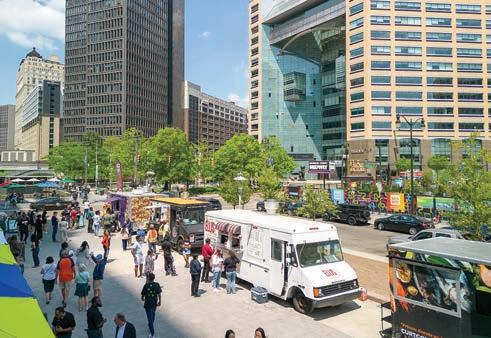
From Paradise Valley to Black Bottom, we’ve buried stories beneath highways and parking lots. This win does not erase that history—but it gives space for new chapters to be written with intention and inclusion.
Campus Martius Park sits at the center of 18 public spaces now under DDP’s stewardship. Those include Cadillac Square, Capitol Park, Grand Circus Park, Beacon Park, and the powerful reclamation project known as Paradise Valley Park and Plaza. Together, these spaces tell a story of a city that is rewriting the rules of urban planning—not just beautifying space, but honoring it.
The strategy behind Campus Martius’ excellence is no accident. Since 2000, DDP has centered innovation, collaboration, and cultural relevance in its mission. It has made Detroit’s downtown a laboratory for urban placemaking, rooted in the belief that public space should not be reserved for privilege. It should reflect the people who built this city,
MAY 10 / SAT / 7:30PM
MAY 16 / FRI / 7:30PM
MAY 18 / SUN / 2:30PM
What this award doesn’t capture—but every Detroiter feels—is what this park symbolizes. For elders who recall downtown when it was dismissed and disinvested. For young people who see themselves skating with ease and joy in a space where their grandparents were once unwelcome. For artists, vendors, food truck owners, and local entrepreneurs who find audiences and opportunities here. This is more than prestige. This is promise.
Detroit has earned this moment—not because we followed the script but because we rewrote it. Not through gentrification or exclusion but through intentional placemaking that opens its arms. And while the work is ongoing— because equity is a journey, not a destination—this award affirms a truth that Detroiters have always known: what we build, we bless. What we nurture grows.
The win also underscores how Detroit continues to evolve as a global destination without losing its local voice. It reminds national audiences that revitalization does not have to come at the cost of culture. And it challenges other cities to take notes—not just on design, but on listening, partnership, and purpose.
To those who cast their daily votes, walked through that park, shared memories, or poured into its soil and systems— this win belongs to you. Campus Martius Park didn’t just climb the rankings. It stayed rooted. And because of that, it keeps rising.



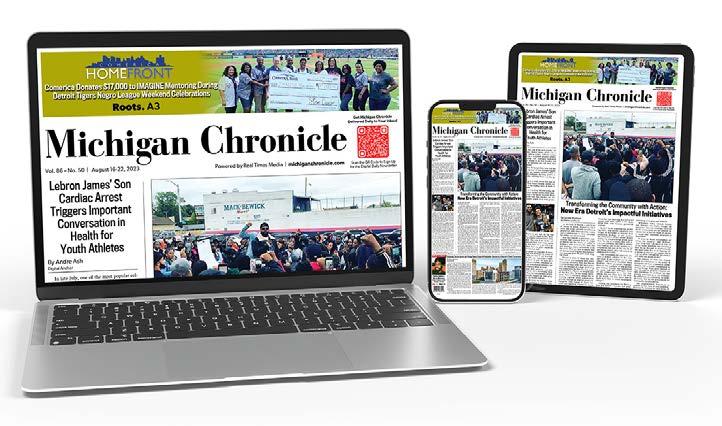


Do you suffer from back or neck pain? Trinity Health has the latest methods and technology to help. Our team looks at many treatment options to create a plan that is right for you. From physical therapy and pain management to advanced spine surgery, say goodbye to living with pain. Reach
By Jeremy Allen EXECUTIVE EDITOR
In his new book Company Men: A Wellness Guide for Black Men in Corporate America, journalist-turned-corporate executive Justin Grant issues a powerful and timely call to action for Black men navigating the pressures of corporate America. Drawing from lived experience, original reporting, and dozens of intimate interviews, Grant unpacks the hidden costs of success—from isolation and anxiety to health challenges—and offers a blueprint for survival and strength. We caught up with Grant to learn more about what inspired the book, why he wants Black men to think like J.R. Smith, and what real wellness looks like in the boardroom. Michigan Chronicle: First off — congratulations on the new book, Company Men! Tell us about your background and what led you to write it.

Justin Grant: Thank you. I appreciate that. My background is in journalism, and my first job was at Reuters. I got that opportunity through the National Association of Black Journalists, which really helped launch my career. But when I arrived in that newsroom, the editor told me on day one that there was skepticism about me even being there.
Instead of motivating me, it created fear and anxiety—and that impacted my performance, my mental health, and even my physical health. Around that time, I also lost my uncle, a CFO at Johnson & Johnson Pharmaceuticals, at just 48 years old. That moment really made me reflect on what the corporate grind does to Black men.
That’s what led to Company Men. Through interviews, data, and personal stories, I realized the stress we face in these environments is uniquely damaging to our health—and I wanted to offer something real, practical, and healing in response.
MC: One of the most memorable ideas from the book is your line, “Don’t be like Mike. Be like J.R. Smith.” Can you explain what you mean by that?
Grant: (Laughs) Yeah, people really love that line. It’s about what I call “irrational confidence.” You know how J.R. Smith played basketball—he could miss ten shots in a row but still believed the next one was going in. He had that shooter’s mentality. That can be questionable on the court—but in corporate America, especially for Black men, it’s essential.
We’re often surrounded by skepticism, silence, and subtle undermining. That’s why I say: Don’t try to be perfect like Mike. Be like J.R.—have that irrational belief in yourself, your ideas, and your worth. We need that level of confidence just to survive in some of these rooms, let alone thrive.
MC: Health is a major theme in your book. Why is that the starting point?
Grant: Because it’s life or death. Literally. Black men have the second-lowest life expectancy of any demographic in the U.S., and research shows that the higher we climb the corporate ladder, the more our health declines.
I’ve seen it too many times—colleagues in their 40s dying from heart disease, strokes, the stress catching up to them. These are successful, high-performing brothers who looked fine on the outside. It’s not just anecdotal—it’s backed by data. That’s why Chapter One is about health. We can’t talk about success without first talking about survival. MC: You’ve said this book is both personal and a call to action. What makes you uniquely qualified to write Company Men?
Grant: I’ve spent 19 years in corporate America and am now an executive at a major U.S. financial institution. But I also come from a journalism background. That means I don’t just have the lived experience—I’ve also done the research, interviewed dozens of Black men, and studied the trends.
I’ve seen how these systems affect us—mentally, physically, socially, and financially. And I’ve seen too many talented brothers not make it to retirement. That’s what pushed me to write this book. It’s not just theory—it’s our reality.
MC: You also write about the art of picking your battles in the workplace. How can Black professionals navigate that while protecting their peace?
Grant: That’s a really important question. In corporate America, especially at leadership levels, consensus building is critical. You only get so many battles, so you have to be strategic. But here’s the thing—Black professionals sometimes lose sight of the very instincts and vision that got them into those rooms in the first place.
I tell a story in the book about a time I was still junior-level, back in February 2020. COVID was starting to make headlines, and our team had planned an activation with our CEO at Disney World. I followed the headlines closely and made the tough call to pull us out—without permission. I got reprimanded, but a few days later, the whole world shut down. That decision probably protected lives.
Even at a junior level, you have to trust your instincts. Respect the process, yes. But never abandon the intuition that got you to the table. MC: Beyond health, what other topics do you tackle in Company Men?
Grant: The book is really about full-spectrum wellness for Black men in corporate spaces. I talk about social wellness—how to build community and stay grounded even in isolating environments. There’s a whole chapter on avoiding the “angry Black man” stereotype and the historical reasons we feel pressure to shrink ourselves.
I also dive into financial wellness—how to negotiate salaries while Black, close the racial pay gap, and turn income into wealth. There’s a section on career strategy, too, helping folks build a personalized roadmap that aligns with their calling, not just their job title.
MC: Why is Company Men needed right now?
Grant: Because there’s no resource quite like this. We’re in a moment where Black professionals are doing better by the numbers—more Black CEOs, higher wages, and greater representation. But with that success comes new stress, new challenges, and often, new levels of isolation. Company Men is about naming those challenges and offering real, prescriptive solutions. We need tools—not just motivation. This book is that tool. And I hope it opens up conversations not just among Black men, but in families, partnerships, and workplaces too.
MC: Where can people get the book?
Grant: It’s available on Amazon, BarnesandNoble.com, Goodreads, and all major online retailers. You might also find it in select bookstores—we actually sold out our local indie shop in Maplewood, New Jersey. The audiobook dropped on March 18, and it’s out on all major audio platforms.
MC: Any final message for readers?
Grant: Just this: We have to protect our health, our minds, and our peace. This book starts with the body, but it’s really about helping Black men reclaim their power in spaces not built for us. And to anyone reading—don’t lose the drive and tenacity that got you here. Tap into your faith, your instincts, and yes—your irrational confidence. It might just save your life.
Company Men by Justin Grant is available now wherever books are sold.

By Darryl Jacobs CONTRIBUTING WRITER
On April 11, 2024, LSU wide receiver Kyren Lacy died by suicide following a police pursuit. His death shocked the college sports world — not only because of the sudden loss of a talented young athlete but because of what it revealed about the quiet, growing mental health crisis facing Black student-athletes in America.
In the aftermath, questions flooded in: What led to this? Who was supporting him? Could it have been prevented?
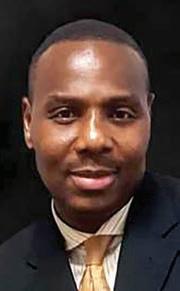
But perhaps the most critical question is this: Who’s truly looking out for our young Black athletes, especially now, in an era when Diversity, Equity, and Inclusion (DEI) initiatives are being rolled back on college campuses across the country?
A Silent Struggle Behind Spotlight
Kyren Lacy was more than an athlete. Like many Black college football players, he carried the weight of expectations far beyond the gridiron — representing family, community, and often, future financial hope. That kind of pressure can be crushing. Add in legal troubles, public scrutiny, and isolation, and you have a volatile emotional cocktail that too often goes unaddressed. The unique challenges faced by Black student-athletes, such as racial discrimination, societal expectations, and financial pressures, contribute to this crisis.
Lacy’s death isn’t just a tragedy; it’s a stark warning that demands our immediate attention. And it’s not an isolated incident.
Across the country, we’ve seen an increase in mental health challenges among student-athletes, particularly African Americans. These young men and women are praised on game day but often left to navigate personal and cultural difficulties alone once the lights go out. And now, at a time when culturally competent mental health resources are more critical than ever, the very programs designed to support these students are being dismantled. DEI Under Fire, Lives in the Balance
In Texas, Florida, and several other states, legislation has been passed to defund or eliminate DEI offices and programming from public colleges and universities. These programs, once vital sources of mentorship, advocacy, and community for minority students, are now disappearing, leaving a void that puts vulnerable students at even greater risk.
Let’s be clear: DEI is not a political agenda — it’s a life-saving framework. These programs don’t offer handouts. They offer support — from mental health counselors who understand racial trauma to leadership initiatives that empower student-athletes of color to find their voice in spaces where they are often the minority. Culturally competent mental
Men grieve in many ways, just like anyone else, but they often express it differently due to societal expectations, upbringing, and personal coping mechanisms. Here are some common ways men process grief:
1. Stoicism & Suppression – Many men are conditioned to be “strong” and may suppress their emotions, choosing to grieve privately rather than openly expressing sadness.

2. Distraction Through Activity – Instead of openly mourning, some men channel their grief into work, hobbies, or physical activities as a way to keep their minds occupied.
3. Anger & Irritability – Grief can sometimes manifest as frustration, impatience, or even aggression, especially when emotions feel overwhelming but difficult to express.
4. Withdrawal & Isolation – Some men prefer to grieve alone, avoiding emotional conversations or social interactions. They might not talk about their loss unless they feel completely safe to do so.
5. Seeking Control – In situations of loss, some men focus on problem solving or taking care of others as a way to regain a sense of control.
6. Delayed Grieving – Men sometimes postpone
health resources are crucial in addressing the specific needs of Black student-athletes, as they can provide support that is sensitive to their unique experiences and challenges.
With these resources gone, who fills the gap?
Athletic Departments Must Step Up
Athletic departments, coaching staff, and university leadership are now responsible for providing the cultural, emotional, and psychological support that DEI offices once helped champion.
That means hiring diverse staff who understand their athletes’ lived experiences. It means funding dedicated mental health professionals trained to work with student-athletes from underrepresented backgrounds. It means creating peer—and alumni— based mentorship networks that reflect the communities these athletes come from.
Above all, it means listening. Student-athletes, particularly those from marginalized backgrounds, have been speaking out about their pressures. Institutions can no longer afford to ignore their voices or only react when tragedy strikes.
The Role of Advocacy and Accountability
In the absence of institutional DEI, external pressure and advocacy matter more than ever. Alums, faculty, and community organizations must hold colleges accountable. The NCAA must also take a stronger stance in requiring mental health and wellness initiatives that include culturally competent care.
Alternative frameworks can and must be created, but they must be intentional, resourced, and deeply rooted in a fundamental understanding of the challenges facing minority athletes. Token efforts will not save lives; only meaningful investments will.
Kyren’s Legacy Must Spark Change
Kyren Lacy should still be here. He should still prepare for the NFL Draft, inspire kids back home in Louisiana, and proudly wear that LSU jersey. Instead, he has become another name in a growing list of young athletes whose mental health needs went unmet until it was too late.
If we genuinely value our student-athletes, we must do more than celebrate their talent. We must protect their humanity.
This means restoring and reimagining support systems, not tearing them down. It means recognizing that equity isn’t about treating everyone equally— giving people what they need to succeed and survive.
The rollback of DEI initiatives may satisfy a political agenda, but it exposes our most vulnerable students. We cannot allow that to be the legacy of this moment.
We owe Kyren — and every athlete like him — better.
Darryl Jacobs is an ESPN & CBS Sports Network Commentator/Analyst, former college head coach, and sports executive with over two decades of experience in collegiate and professional athletics. He is also a passionate advocate for athlete mental health and leadership development.
grieving, by either suppressing it or avoiding it until it becomes impossible to ignore, sometimes-surfacing years later.
7. Silent Suffering – Instead of verbalizing grief, men may express it through subtle signs like changes in sleep patterns, appetite, or engagement in risky behaviors. Of course, not all men grieve this way. Some are open with their emotions, seek support, or go to therapy. But, societal norms often shape how grief is expressed. The most important thing is to acknowledge and process grief in a way that leads to healing, rather than repression. Here are a few ways to support him:
• Give him space, but do not disappear. Let him know you are there without pressuring him to open up.
• Offer practical help. Sometimes taking care of everyday tasks (meals, errands, etc.) is more helpful than deep conversations.
• Invite, but do not push. Encourage activities that might help him process grief, like exercise, hobbies, massages, a sound bath session or even just a low-pressure social outing.
• Listen without trying to “fix” things. If he does talk, resist the urge to give advice—just be present.
• Check in over time. Grief does not have a timeline, and men who suppress it might need support weeks or months later, when others have moved on. For additional support contact: AzalBenneLockettFoundation.org DrPortiaLockett.com https://www.facebook.com/portialockett/ https://www.linkedin.com/in/drportialockett/ Http://www.youtube.com/portialockett/
By Amber Ogden STAFF WRITER
A new season of golf is underway, and this year, thousands of Metro Detroit youth have a unique reason to pick up their clubs. Bank of America (BoA) has officially launched “Golf with Us”, a national initiative that’s transforming access to the sport for kids ages 6 to 18 by offering rounds of golf for just $5 or less at participating courses.
Created in partnership with the nonprofit Youth on Course, the program allows young players to enjoy the game and build essential life skills like discipline, patience, and confidence. For Detroit-area families, this initiative provides a welcome pathway to a game often seen as financially out of reach.
According to the National Golf Foundation, as of 2023, more than 36% of junior golfers in the U.S. come from underserved communities, a significant increase from just 15% in 2000. This increase is driven in part by outreach programs like Youth on Course and First Tee and local community initiatives aimed at making golf more accessible and inclusive.
Star Crawford, SVP, Market Executive, Bank of America Detroit, highlighted through Golf with Us Bank of America is opening doors for young people in Metro Detroit, demonstrating that with dedication and support, they can achieve

great things both on and off the golf course.
“By providing accessible opportunities to engage with the game, we’re helping to build confidence and life skills that extend far beyond the fairway,” Crawford said.
The “Golf with Us” program made its official debut during the 2025 Masters Tournament, where Bank of America is a Champion Partner and has quickly gained traction in 97 markets across the U.S. In Metro Detroit alone, youth golfers can now tee off at several
local courses for just a frac-
tion of the traditional price.
Participating courses in the Metro Detroit region include Chandler Park Golf Course, located at 12801 Chandler Park Drive in Detroit; Royal Oak Golf Center at 3500 Edgar Avenue in Royal Oak; and Sycamore Hills Golf Club at 48787 North Avenue in Macomb. In addition to low-cost rounds, Golf with Us will host a series of free clinics in select cities, including Detroit. These events will feature appearances from professional golfers, local
Teen HYPE is officially all grown up
Teen HYPE, one of Detroit’s most influential youth development organizations, is celebrating a major milestone: its 21st anniversary. What began in 2004 as a bold vision to uplift and empower young people has since grown into a transformative force, shaping futures, amplifying youth voices, and impacting more than 55,000 lives across the city and beyond.
Ambra Redrick, CEO of Teen HYPE, announced that the organization is officially 21 years old, marking a significant milestone. This achievement is not just a celebration of a birthday; it represents a strong indication that Teen HYPE is on the right path, with much more growth ahead.
Over the years, we’ve had the joy of working with incredible young people and watching them grow into confident, capable adults doing amazing things in the world,” Redrick said.
“As we mark this moment, we’re committed to growing right along with them and continuing to serve youth for generations to come. Here’s to the next chapter.”
Under Redrick’s leadership, Teen HYPE, short for Helping Youth by Providing Education, has become a beacon for youth in Detroit, blending health education, leadership development, career exposure, and emotional support to prepare teens to lead with purpose. Redrick’s vision and impact have not gone unnoticed; she was recently honored with the prestigious 2025 Skillman Visionary Award, which recognizes leaders transforming education to meet the future head-on.
To mark this coming-ofage moment, Teen HYPE is unveiling a brand-new visual identity, a vibrant logo symbolizing transformation, unity, and momentum.
“Our new logo represents growth, progress, and possibility. It reflects not just who we are, but who we are becoming future-focused, deeply rooted, and ready for the next chapter,” Redrick said.
“It’s more than a visual

refresh, it’s a re-commitment to the values that have guided us for two decades, and a bold step toward everything we’re building next.”
The celebration also welcomes fresh leadership.
Eight dynamic changemakers have joined Teen HYPE’s Board of Directors, bringing with them a powerful mix of passion, innovation, and experience:
Katrenia Camp, Family Independence Manager, State of Michigan
Rita Dandridge, Senior Director, Willis Towers Watson
Chris Dargin, Founder and CEO, Synthesystem
Bethany Howard, City Walls Project Manager, City of Detroit
Edwina King, Associate Director of Legislative Affairs and Equitable Development
Harolyn Nimmo, Deputy Director and Chief Health Equity Officer, Wayne County Health
Kristian Shore, Director of Diversity & Inclusion, University of Detroit
Jesuit High School
Jake Smith, Financial Advisor, Thrivent Looking ahead, Teen HYPE has ambitious plans: expanding its reach, launching new initiatives, deepening community partnerships, and continuing to elevate youth voices. The mission remains the same— but the scale is growing.
Dr. Nutrena Tate, Board Chair of Teen HYPE, highlighted she is thrilled to welcome these exceptional leaders to the board.
“Their dedication to youth and community engagement will be invaluable as we continue to uplift the youth and generations to come,” Tate said.
“With the addition of these new board members, the organization is poised to expand its impact even further. Each of them embodies the spirit of our mission and brings fresh ideas that will help us drive a meaningful, measurable impact in the years ahead.”
athletes, and notable community leaders, offering mentorship and inspiration to young golfers beyond the game itself. Golf with Us builds on the proven success of Youth on Course, a national nonprofit that has helped young players complete over 2
Adam
“Through this partnership with Bank of America, we’re making it possible for more kids across the country to step onto the course and discover what’s possible,” Heieck said.
“This partnership is about more than just golf; it’s about opening doors and changing futures.”
The
Whether
million affordable rounds of golf. In Michigan alone, Youth on Course supported more than 12,000 rounds for kids in 2024, a number that is expected to grow significantly with this year’s added support from Bank

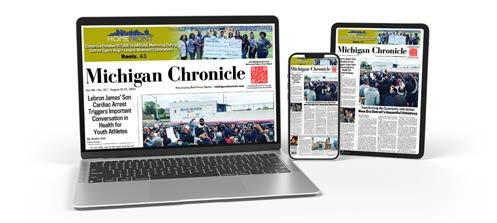


ATTENTION: WAYNE COUNTY RESIDENTS
Would you benefit from affordable, high quality rental housing?
MSHDA’s Project-Based Voucher (PBV) may be able to help. The PBV program is a federally funded rental subsidy program that may assist persons living at Art Center Townhomes with paying their rent.
MSHDA is partnering with Art Center Preservation LDHA LLC, KMG Prestige, Inc and Community Management Associates, Inc. to make rental assistance available for six (6) two-bedroom units and one (1) three-bedroom unit at Art Center Townhomes located at 5351 S. Chrysler Drive, Detroit, MI 48202.
The PBV waiting list will be established by MSHDA beginning Wednesday, April 23, 2025, and will remain open indefinitely. You may qualify for assistance, if your family income falls within the allowable limits (50% percent of area median income) for Wayne County.
Staff at Art Center Townhomes will be accepting inquiries beginning Wednesday, April 23, 2025. Please call 313-874-1730 between the hours of 9:00 a.m. and 4:00 p.m. Monday through Friday, to schedule an appointment to determine your eligibility for placement on the project-based voucher waiting list for rental assistance.
NOTE: Proof of legal identity (birth) and proof of a valid Social Security number will be required for all members of the household.








The Detroit Public Schools Community District is seeking proposals for subcontractors under RFP 26-0011 New Southwest PK-8 School.
Architect/Engineer: Fanning Howey 4219 Woodward Ave., Suite 301 Dearborn, MI 48201
Construction Manager: G ilbane/KEO & Associates, Inc./Brix Corporation 500 Woodward Avenue, Suite 2250 Detroit, MI 48226
There will be a non-mandatory Pre-Bid conference for this RFP that will take place virtually on April 25, 2025 at 2pm. The meeting can be accessed at the below link.
https://tinyurl.com/bbyf2dze
Call-In: (313) 462-2305
Conference ID: 833 333 45#
The due date for Proposals is May 13, 2025 at 12pm. Proposals must be submitted electronically via Building Connected by due date and time. Late bids will not be accepted.
The Public Opening will occur virtually at 12:30p.m. on May 13, 2025, and can be viewed at the below link:
https://tinyurl.com/ye24z2a8
Call-In: (313) 462-2305
Conference ID: 662 907 14#
This Project is subject to Michigan State Prevailing Wage Laws
(Michigan Public Act 10 of 2023) and the Contractor must pay prevailing wages and fringe benefits to all of Contractor’s, and is subcontractors’, construction mechanics working on the Project in accordance with Michigan Public Act 10 of 2023. All bids must be accompanied by a sworn and notarized statement disclosing any familial relationship that exists between the submitting company and any employee of DPSCD. DPSCD shall not accept a bid that does not include this sworn and notarized disclosure statement. A bid bond in an amount not less than five percent (5%) of the base bid is also required.
- Legal Notice
The Detroit Service Learning Academy District announces the 2025/26 open enrollment period for grades K-8 through Tuesday, May 27 between the hours of 8:00 a.m. and 4:00 p.m. at the Detroit Service Learning Academy 21605 W. 7 Mile Rd. Detroit MI 48219, the Redford Service Learning Academy 25940 Grand River Ave. Redford MI 48240 or Oak Park Service Learning, 21700 Marlowe, Oak Park, MI 48237 (Grades K-8).
In the event, student enrollment applications exceed available space, a random selection drawing will be held if needed on Monday, August 18, 2025 8 a.m. to 4 p.m. held at 21605 W. Seven Mile Rd. Detroit, MI 48219. This institution is prohibited from discriminating on the basis of race, color, national origin, sex and disability.
Academy of Warren, a Tuition-Free Public School Academy, announces its Open Enrollment Period for the 2025-2026 school year for grades K-8. Applications may be picked up at the Academy (586-552-8010) or online at www.academyofwarren.net.
Hours to pick up applications will be May 1, 2025 thru June 13, 2025 from 8 am to 4 pm Monday- Friday; Saturday May 17, 2025: 9:00 am to 1:00 pm; May 28, 2025: 3:30 pm to 6:30 pm.
If applications exceed the number of available spaces, a random selection will be held at Academy of Warren, 13943 E. 8 Mile Road, Warren, MI 48089, on June 27, 2025.
Metro Engineering Solutions, LLC has available positions of Lead Electrical EngineerPower Systems in Northville, MI. Position requires a Master’s degree in Electrical Engineering & 24 months experience as an Electrical Engineer. Position also requires: Exp. must include: 1) 24 mos. exp. performing electrical calculations for conductor sizing & conduit sizing as per National Electrical Code (NEC) code book; 2) 24 mos. exp.
SKM Power Tool &/or CYME software; 3) 18 mos. exp.
engineer for industrial gas compressor station; & 4) 3 mos. exp. working as
on-site electrical engineer for electrical substation erection projects. Exp. reqs. may be met concurrently during the same time period. Job duties: Perform power system analysis for projects related to electrical power distribution systems. Perform electrical calculations for conductor sizing & conduit sizing as per NEC code book. Lead engineering team for projects involving field work pertaining to substation &/or industrial gas compressor station erection projects. As needed, lead & manage a group of engineers & planners working on power distribution & protection projects. Use software tools including SKM Power Tool & CYME for electrical designs. Create project cost estimates & develop standard working instructions for different types of projects. Train new engineers in engineering & designing practices along with industry standard software tools. Manage the finances of assigned projects & ensure deliverables are made with acceptable quality while staying under targeted budgets. We maintain a drug-free workplace & perform pre-employment substance abuse testing. Refusal to submit to testing will result in disqualification of further employment consideration. Qualified applicants should e-mail resume & verification of reqs. to Allison Domen, Human Resources Manager, Metro Engineering Solutions, LLC at adomen@metroes.net.
Hardware Electrical Engineering Lead
Visteon Corporation has an opening for a Hardware Electrical Engineering Lead in Van Buren Township, MI responsible for Follow Product Development Process to develop and deliver HW designs. Review and analyze customer requirements and component specifications. Bachelor's degree (or foreign academic equivalent) in Electrical Engineering, Electronics Engineering, or related field of study and four (4) years of experience as a Hardware Electrical Engineering Lead or a related occupation. International and domestic travel required, as needed, up to 5%. Any applicant who is interested in this position should apply to job reference number HARDW019680 at https://www.visteon.com/careers/ job-opportunities/
New Boston, MI, Brose North America. Plan, engr, &improve plant productivity, product throughput, &worker sfty using Process Failure Mode &Effects Anlys, Sigma, 8 Disciplines, 5S Method, Fishbone Diagram, &DraftSight tool, to continuously improve machines (incl. workstation devices &end of line testers), mfg processes, &plant facilities. Anlyz &improve Overall Equipment Effectiveness (OEE); dsgn &optimize Value Stream; &implement Lessons Learned, during production of automot mechatronic door modules incl. carrier plates, latches, window regulators in high volume mfg plant environ. Assure production &dlvry of door modules on Just in Time, Just in Sequence, batch, &svce parts bases to OEM vehicle maker. Dvlp &maintain product Bills of Material, change masters, routings, &production versions in SAP Matls Reqmt Planning sys. Bachelor, Industrial, Bionic, Mechatronics, Electrical, or Automot Syss Engrg, or related. 24 mos exp as Engr or related, anlyzg &improving OEE; dsgng &optimizing Value Stream; &implementing Lessons Learned, during production of automot door modules in high volume mfg plant environ, or related. E-mail resume to Jobs@brose.com (Ref#23865).
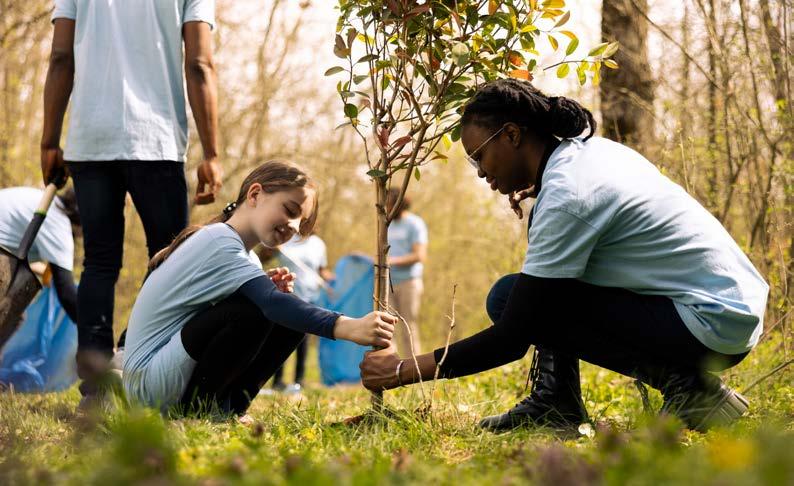
(StatePoint) Global Volunteer Month, celebrated in April, is a time to honor volunteers while encouraging volunteering in communities around the world.
This annual celebration is especially pertinent right now. According to a Pew Research report, only 54% of Americans feel a connection to others near them.
“Communities around the country are facing increased needs at a time when many people are feeling more isolated. Volunteering fills the gaps to strengthen community and the fabric of our society,” says Jennifer Sirangelo, president and CEO of Points of Light, the world’s largest organization dedicated to increasing volunteer service.
But as Sirangelo points out, volunteering doesn’t just build healthier and more equitable communities, it’s also good for the individuals who are lending their time and talents. “Engaging in volunteer activities has been identified as an effective way to build confidence, alleviate anxiety and depression, and provide a sense of purpose and connection,” she says.
Here are some ways you can take action this Global Volunteer Month and beyond: Take the Pledge: Let your community know you are committed to volunteering and service by taking the Points of Light’s Global Volunteer Month Pledge. With nearly 50% of volunteer postings going unfilled, your participation can help meet critical community needs and ensure essential services are delivered. Already
committed to a cause you care about? Take this opportunity to deepen your engagement. Commit to one extra volunteer project a month, or consider taking on a leadership position with an organization you work with.
Thank a Volunteer: Volunteers are the heartbeat of strengthening communities, and throughout the month, you can help recognize the vital role they play. Thank a volunteer or organization that is making an impact in your community starting on April 1 and throughout the month using the hashtag #ThankAVolunteer.
Spread the Word: Use social media to spread the word about the importance of volunteering using hashtags like #GlobalVolunteerMonth. To inspire others to take action, share your own volunteer story using #WhyIVolunteer.
Get Started: Not sure how to get started or where your efforts will make the biggest social impact? Visit Points of Light Engage, at engage. pointsoflight.org. This enormous database allows you to search for volunteer opportunities in your city or zip code based on your interests. Whether you’re volunteering on your own, with coworkers, or with family, you’ll be sure to find an opportunity that’s right for you.
“Volunteering is needed more than ever before. This April, we are urging everyone to join us in taking action. Lend your time, talent and passion to making a real difference in your own neighborhood and to creating a better world,” says Sirangelo.


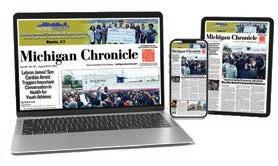

Tax refunds have started rolling in, which means many people are looking use this influx of cash to make purchases they’ve been putting off. According to an Oxford Economics report, the amount of money received from income tax refunds this year could be among the highest in recent years, so many people may have more money in their pockets to spend this spring.
exterior cmpnts incl. door handles, mirrors, lamp internals &exhaust tips, using Autodesk Alias AutoStudio, Autodesk Maya, NX &VRED tools, for U.S., global &emerging markets. Interpret, define, conceptualize &execute unique solutions to technical challenges &provide creative proposals to capture design intent from initial concept thru mass production achieved in various stages according to GVDP, while collaborating with engrg, packaging, human factors, &tooling teams to assure minimum radii/draft, tooling &safety reqrmnts in compliance w/ U.S., European &China standards. Bachelor, Transportation or Industrial Design. 60 mos exp as Digital Sculptor, Digital Modeler, or related, designing or developing 3D Class A surfaces of full vehicle psgr vehicle exterior cmpnts incl. fascias, grills, head/taillamps, doors, fenders, ABCD pillars, &liftgates, using Alias AutoStudio, NX &VRED tools, for U.S., global &emerging markets, or related. Mail resume to Ref#1827-201, GM Global Mobility, 300 Renaissance Center, MC:482-C32-C66, Detroit, MI 48265.
many people are looking to use this influx of cash to make purchases they’ve been putting off. According to an Oxford Economics
of money received from income tax refunds
One purchase typically rises to the top this time of year: used vehicles. The Oxford report shows used vehicles are one of the most popular purchases for Americans during refund time as this coincides with higher resale values of used vehicles. When making purchase, it’s important to consider several factors to make a smart financial decision.
pockets to spend this spring.
One purchase typically rises to the top this time of year: used vehicles. The Oxford report shows used vehicles are one of the most popular purchases for Americans during tax refund time as this coincides with higher resale values of used vehicles. When making this purchase, it’s important to consider several factors to make a smart financial decision. Make Sure the Purchase Fits Within Your Budget
Make Sure the Purchase Fits Within Your Budget
Data from Kelley Blue Book and Cox Automotive suggests average used car prices around 50% less than new vehicle prices. Trusted used car companies and dealerships often feature a wide selection of inventory, including different makes and models, customers can select a vehicle that excites them and fits within their budget. “While there are several considerations to keep in mind when shopping for a consumers should never exceed their budget,” said Laura D. Adams, personal finance expert, host of the “Money Girl” podcast and a paid Enterprise Car Sales spokesperson.
“A vehicle that is near new is often an excellent sweet spot for consumers looking quality without wanting to make the leap to purchase an expensive, new vehicle.”
Data from Kelley Blue Book and Cox Automotive suggests average used car prices are around 50% less than new vehicle prices. Trusted used car companies and dealerships often feature a wide selection of inventory, including different makes and models, so customers can select a vehicle that excites them and fits within their budget.
Searching for a vehicle with a retailer you trust can help make it easy to stay within budget. For example, with Enterprise Car Sales, the price listed is the price you’ll pay.
The more you can invest in the down payment on a vehicle, the lower your monthly
BEVs in GVDP for Vehicle Motion Embedded Controls (VMEC), Body Electronics, Active Safety (AS), telematics, &infotainment. Review, analyze &coordinate the testing &modification of BEV system &cmpnt level SW for electrical validation of VMEC &AS syss incl. Long/Short Range Radars, Rear Vision/360/Driver monitoring cameras, antennas, Body & Vehicle Integration Control Modules, &features incl. Adaptive Cruise Control, Lane Keep Assist, Autonomous Driving Features, Emergency Braking, Collision Mitigation, Alerts, &related module &feature validation status plans for vehicle prgrms, using PQMS, NX, vSpy, Teamcenter (Tc), &ECM tools. Perform on time SW &HW validation of embedded module ECUs, thru design/production/SW iteration validations. Bachelor, Electrical, Computer, Mechatronics, or Mechanical Engrg. 12 mos exp as Engineer, testing or verifying embedded telematics &infotainment embedded ECUs, using Tc &vSpy tools, or related. Mail resume to Ref#407-1175, GM Global Mobility, 300 Renaissance Center, MC:482-C32-C66, Detroit, MI 48265.
“While there are several considerations to keep in mind when shopping for a vehicle, consumers should never exceed their budget,” said Laura D. Adams, personal finance expert, host of the “Money Girl” podcast and a paid Enterprise Car Sales spokesperson. “A vehicle that is near new is often an excellent sweet spot for consumers looking for quality without wanting to make the leap to purchase an expensive, new vehicle.”
Searching for a vehicle with a retailer you trust can help make it easy to stay within your budget. For example, with Enterprise Car Sales, the price listed is the price you’ll pay.
Keep the Monthly Payment Low
Senior Design Sculptor
The more you can invest in the down payment on a vehicle, the lower your monthly cost will typically be and the less interest you will typically pay over the length of the loan. This can lead to lower, more manageable monthly payments.
“In setting a budget for a quality used vehicle, it’s important to consider the initial down payment, the monthly payments, and the interest,” Adams said. “When consumers can put a little more toward the initial down payment, while staying within budget, they often thank themselves later when they have lower monthly payments and less interest accrued.”
There are many online resources that can help consumers make this calculation. For example, an auto loan calculator can show you how a down payment can affect interest charges.
Purchase a Reliable Vehicle
No matter who you buy from, ensuring you are purchasing a high-quality, reliable vehicle is of the utmost importance. Do your research before signing on the dotted line and conduct a test drive if you can.
Warren, MI, General Motors. Plan &perform advanced surfacing concepts &development of Class A surfaces of full vehicle exterior sys. Interpret &define design intent of designer while directly collaborating w/ engineering, packaging, human factors, &tooling teams. Design &develop 3D Class A surfaces of conventional ICE, diesel, BEV &AV full vehicle psngr car, truck &SUV exterior cmpnts incl. front &rear fascias, grills, headlamps, taillamps, doors, fenders, A,B,C &D pillars, skid plates, liftgates, truck beds &detailed exterior cmpnts incl. door handles, mirrors, lamp internals &exhaust tips, using Alias AutoStudio, Maya, NX &VRED tools, for U.S., global &emerging markets. Interpret, develop, &perform physical sculptures, &evaluate physical surfaces &digital sculptures in Alias (surfaces to mill), interpret sketches &drawings, &develop interior &exterior clay models of full vehicles (full-sized models) &cmpnts (and cmpnts in steel, carbon fiber, wax, low density foam (Renboard), rubber &wood) &scale models, working on 1-3 new concept psngr vehicles, facelifts &show cars at any one time. 36 mos exp as Sculptor or Designer, designing &developing 3D Class A surfaces of
“When conducting your search, it’s important to put companies and dealerships you trust at the top of your list,” Adams said. “Maintenance costs can sometimes creep up down the road, so it’s important to make this significant purchase from a company or dealership you trust.”
&BEV full vehicle psngr vehicle
fenders,
cmpnts incl. fascias, grills,
AutoStudio,
&liftgates,
&VRED tools, for U.S., global &emerging markets, or related. Mail resume to Ref#455, GM Global Mobility, 300 Renaissance Center, MC:482C32-C66, Detroit, MI 48265.
Some dealers also provide additional benefits to help protect a purchase. For example, all vehicles purchased through Enterprise Car Sales are “Enterprise Certified,” pass a rigorous inspection by ASE-certified technicians and come with a 12-month or 12,000-mile limited powertrain warranty (whichever occurs first), 12 months of roadside assistance and a 7-day or 1,000-mile (whichever occurs first) buyback policy.
With a little research and careful planning, you can find a reliable used vehicle that excites you. Visit enterprisecarsales.com for more information.

